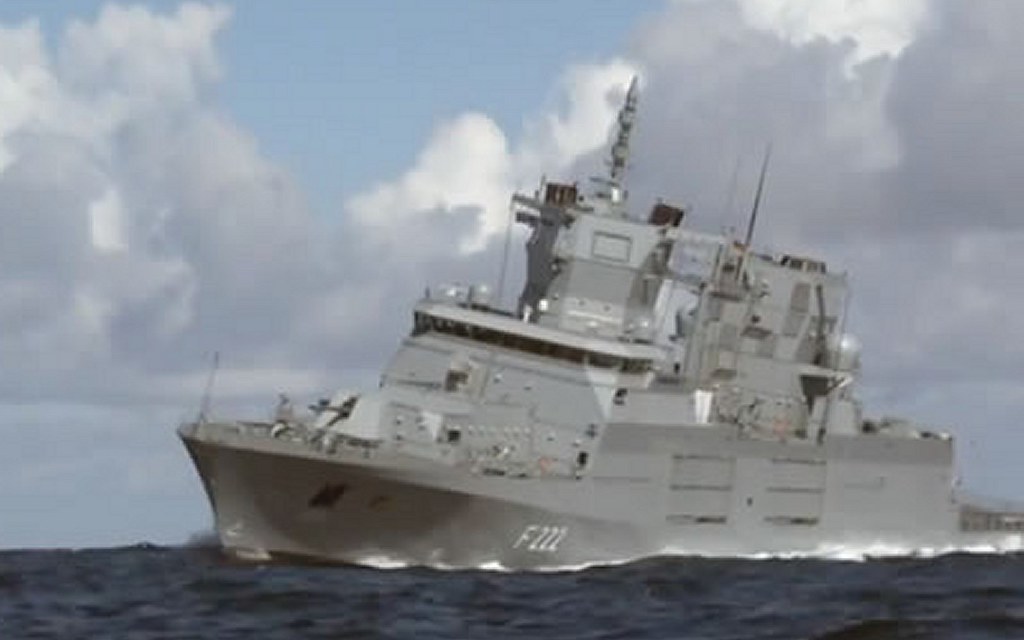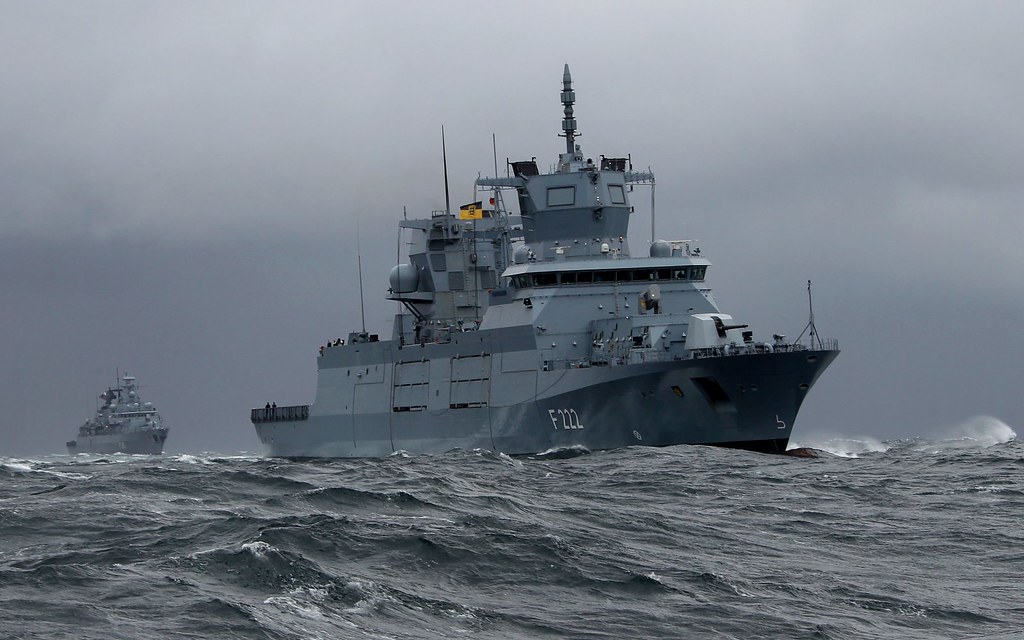 |
|
|
|
The Type 125 Baden-Württemberg class of frigates, currently in development for the German Navy is a joint-venture of Thyssen-Krupp and Lürssen deevelopment. Although the F125-class are officially classified as frigates, in size they are comparable to destroyers. These vessels have a full load displacesment of more than 7,200 tons, making them the largest frigates in the world. They are being built to replace the Type 122 Bremen class frigates of which eight were built. Three of the Type 125 vessels have already been launched, and so Germany has already retired four of its eight Bremen Class vessels. As of yet, only one of the new vessels is about to be commissioned, th F222 the Type 125 Baden-Württemberg. Two more have been launched and they are the F223 Nordrhein-Westfalen which was launched 16 April 2015, and F224 Sachsen-Anhalt which was launched 4 March 2016. Compared to the Bremen class, which were built with Cold War-era conditions and potential conflicts in mind, the Type 125 are being built to be multi-role, but principally directed at surface warfare, with surface and land attack capabilities its strong suite. Anti-submarine defense will be handled by two helicopters it can carry, and anti-air defense is mainly for short range, close-in defenses using two RAM launchers with 21 missiles each. F125 will have much enhanced land-attack capabilities. This will better suit the frigates in possible future peacekeeping and peacemaking missions. For such reasons, the F125 will also mount non-lethal weapons. Major design goals also incluyded reduced radar, infrared and acoustic signatures (stealth technology). The slanted superstructure and use of stealth material and characteristics are evident on the vessels. Other important requirements include long maintenance periods, such as the capability to deploy F125 class frigates for up to two years away from home with an average sea operation time of more than 5,000 hours per year (that's nearly 60%) which includes operation under tropical conditions. As a result of this ter requirement, a combined diesel-electric and gas propulsion has been chosen for the machinery. This allows the substitution of large and powerful diesel engines for propulsion and sets of smaller diesel generators for electric power generation with a pool of med-sized diesel generators, reducing the number of different engines. To enhance survivability of the frigates, important systems are laid out in a two island principle, whih is evident with the two larger superstructures on the ship just in front o amidships, and another behind it. The aerials of the Cassidian TRS-4D Active electronically scanned array radar will be distributed over the two pyramids. This will ensure that the ship remains operational in case of severe damage. It will also allow F125 frigates to keep station if something breaks down and no replacement is available. An initial batch of four frigates was ordered by the German Navy on 26 June 2007. The initial batch of four ships costs around 2.2 billion Euros. In April 2007, a contract with Finmeccanica was signed for delivery of Otobreda 127 mm Vulcano main guns as well as remote-controlled light gun turrets for the F125. However, the 155mm MONARC gun, as well as the naval GMLRS rocket launcher, were later dropped due to problems with the navalization of these systems. As a result, the ships are equipeped with a special 127mm naval rifle with long range munition capabilities, and are equipped with ten smaller guns for defence against air and surface targets. The vessels are also armed with non-lethal weapons, such as water cannons and searchlights for non-provocative deterrence and defence. The charateristics of these frigates are as follows:
Displacement: 7,200 tonnes
The lead ship in class, the Baden-Württemberg, was laid downin NOvember 2011, launched on 12 December 2013, delivered to the GErman Navy in November 2016, and is slated for commissioning in 2017. This was a major undertaking for Germany and is the largest surface combatant warship Germany has built since World War II. However, there has been some controversy. The ship is large, and has a lot of space. Many missions are expected to be conducted using the space modularly, but there is no provision for longer range surfact to air, or longer range land attack missiles from typical VLS systems that such a large combatant should carry. With 42 RAM cells, the ship will be capable of defending itself only in th elast seconds of attack by missiles, and the 127mm gun using the Volcanoe minutions provides decent land attack capabilities, but not the type of heavier 155mm batter type ground support originally envisioned. With eight anti-surface missiles, the ships are armed no better in that regard than the much smaller vessels they are replacing. For anti-submarine warfare they carry the same two type helicopters the Bremen class carry, but they do not have their own anti-submarine sonar that the Bremen class do have. So, there has been questions raised as to why such a large vessel is needed to replace the smaller BRemen class. It is true that the 127mm gun with the Volcamo munitions is far superior to the 76mm gun on the BRemen, but it has come at significant cost. Just the same, the vessels are also much more stealthy, are built to be more survivable, and will be capable of much greater staying power and range than the Brmen class. It is possible that the Gemrmans will not order any more than the four vessels already ordered to replace the eight Bremen class because another design, the Type 128 is already being designed which will use much the same hull as the Ty[pe 125, but wull include either 32 or 48 VLS cells that are capable of carrying much longer ranged ESSM and standard missiles for air defnse, and capable of carrying LACM (Land attack cruise missiles) as well. Time will telkl whether the Germans elect to bring forward these vessels, but the lieligood seems great at this poitn. In the mean time, the Baden-Württemberg, F222, prepares to commission and is an impressive vessel in its own right.
The major model makers have not made any model of the Baden-Württemberg vlass to this date, particularly not in 1/350 scale. However, a company called Shpaeways, which has oened up the market to 3D design and printing of models and other items, has opened the door to the production of many scales of models. A company called Dutch 3D NAval Miniatures, offers several vessels that are not otherwise available on the market and delivers them in 3D PRinted material in a waterline only model. These vessels are similar to resin, but they are made with a 3D prnting process and are not solid. Theyare not chweap. The 3D Baden-Württemberg costs $1488 dollars and you get a vessel that is completed, including aeverything but the small details. Dutch 3D Naval Miniatures has several other 1/350 scale vessels that may be of interest to enthusiasts to take and then utilize after-market parts and scratch building to detail out. In addition to the Baden-Württemberg class, they have (among others) all fo the following:
HMAS ANZAC frigates with the new 3D anti-air upgrade, Here's how the model looks from the box when it arrives::
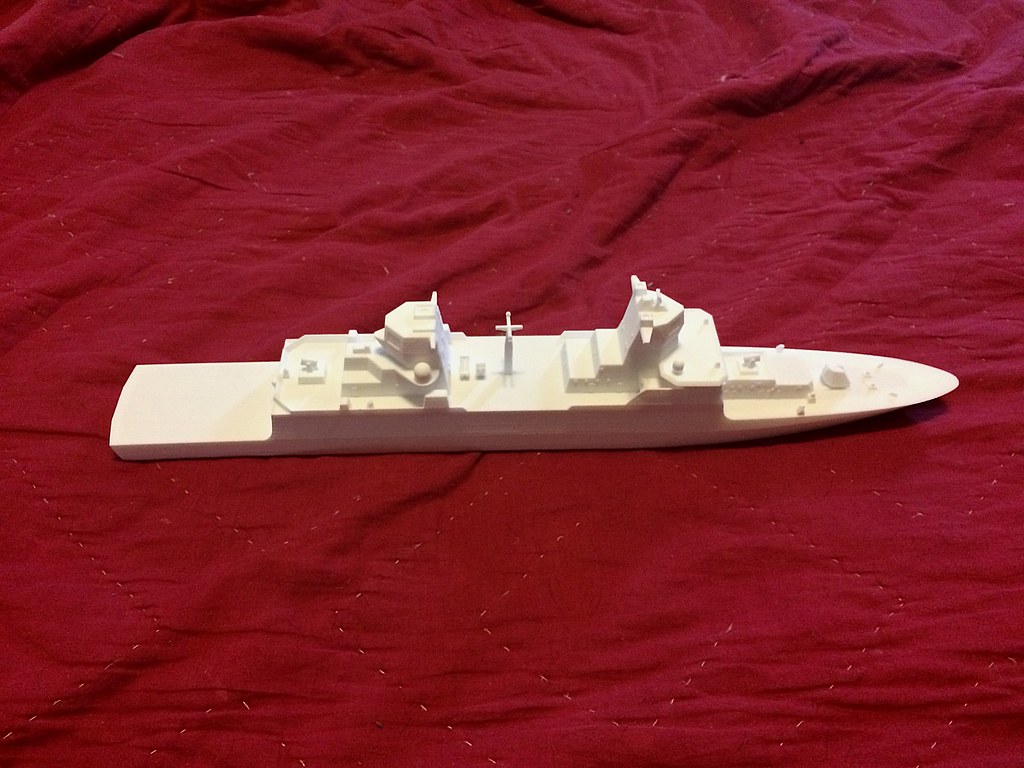


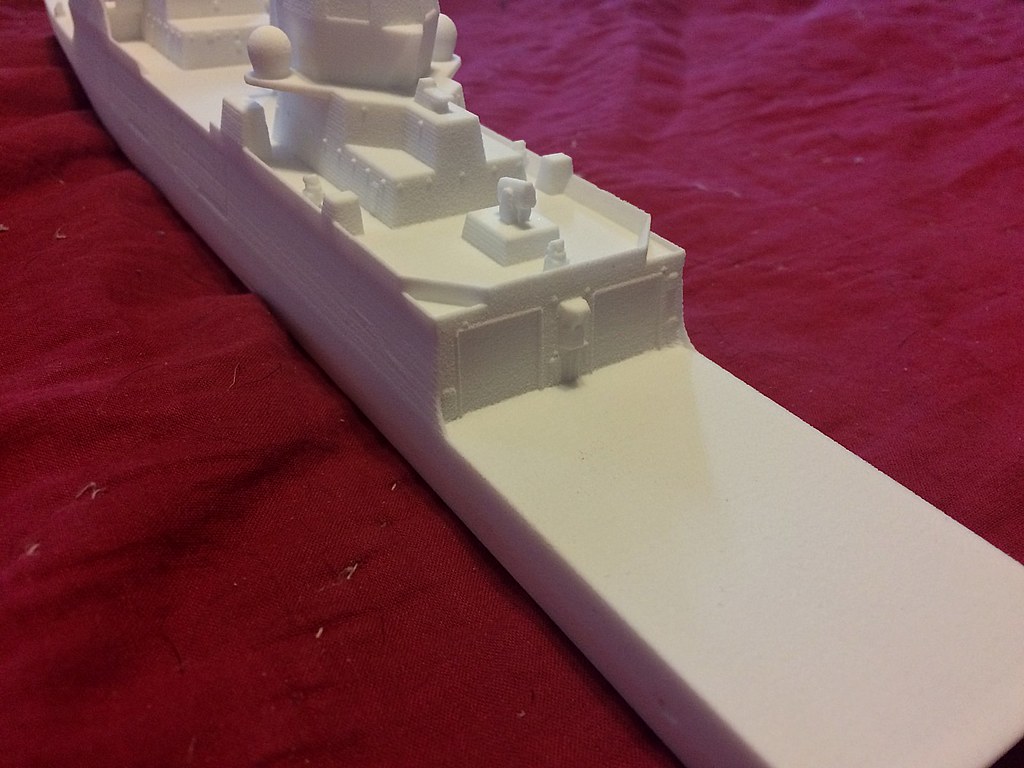
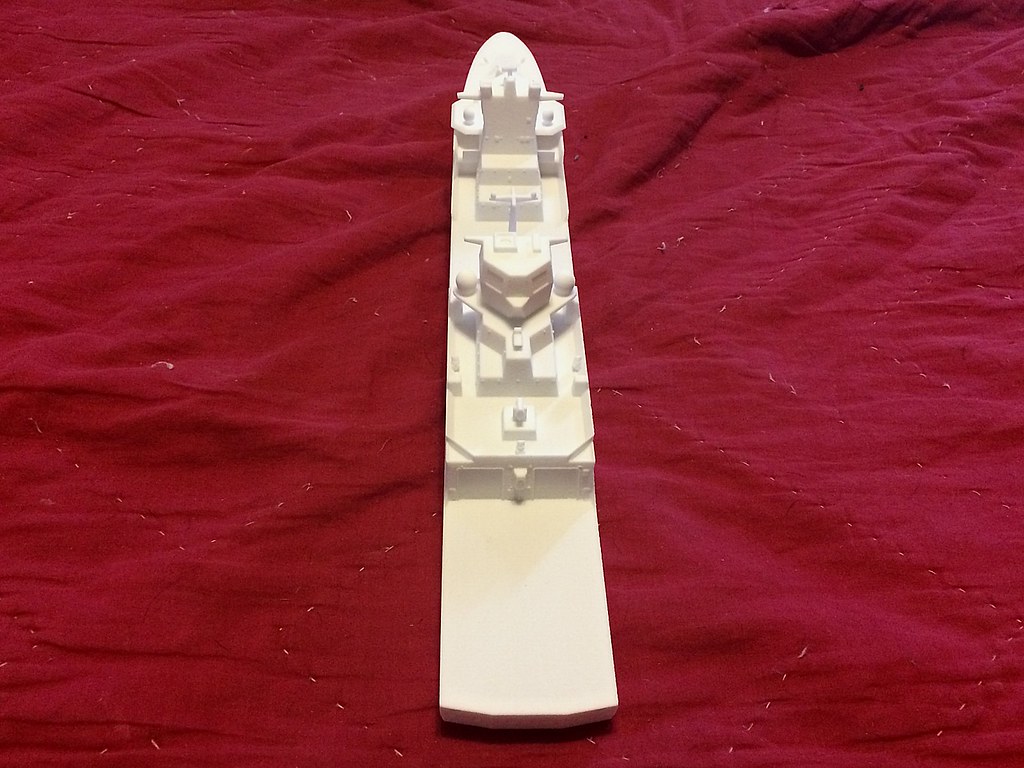
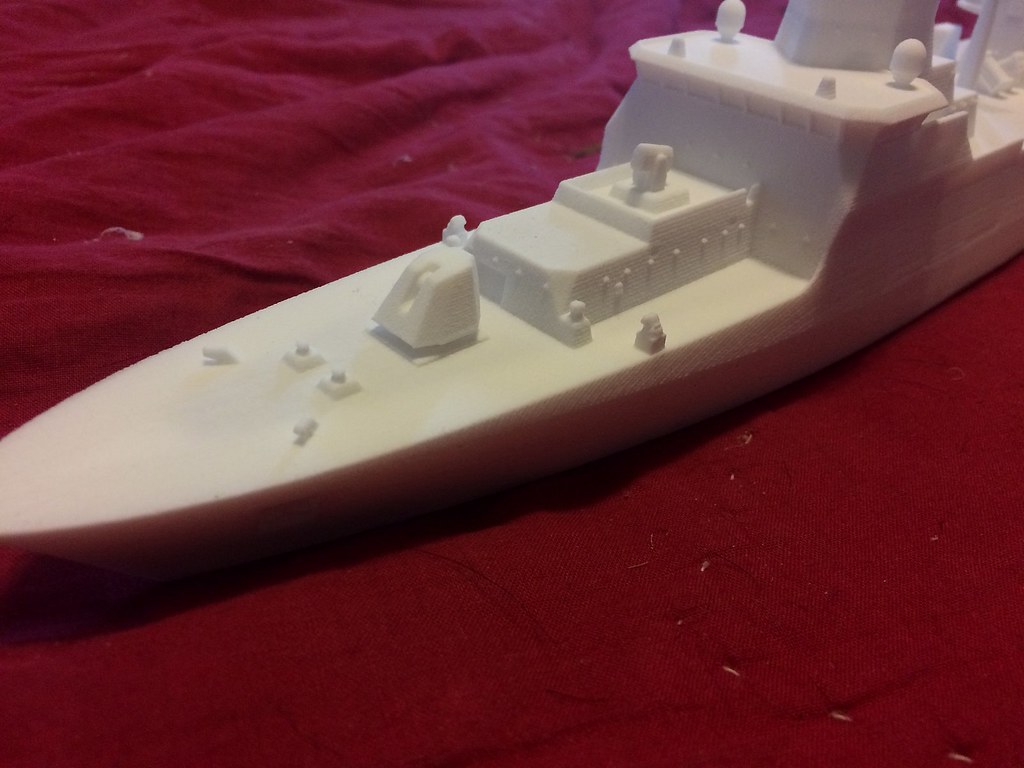
The Build - Removing the Harpoon missiles and RAM launchers, painting the hull, adding the after market weapons - March 1, 2017 I started the model by painting the hull and vertical surfaces in neutral gray and the main deck and auxillary decks in a flat dark gray: Istarted this build off by removing the harpoon missiles and RAM launchers that came molded into the ship. The RAM launchers were not too bad, but the Harpon launchers were without detail and to proper scale or form. I used Harpoon missiles left over from a Trumpeter Areligh Burk Flight I vessel in 1/350 scale, and RAM launchers from Veteran Models in 1/350 scale. I then painted the vessel, vertical surfaces in nuetal gray and decks in Mediaum Sea Gray. Here's how that looked:
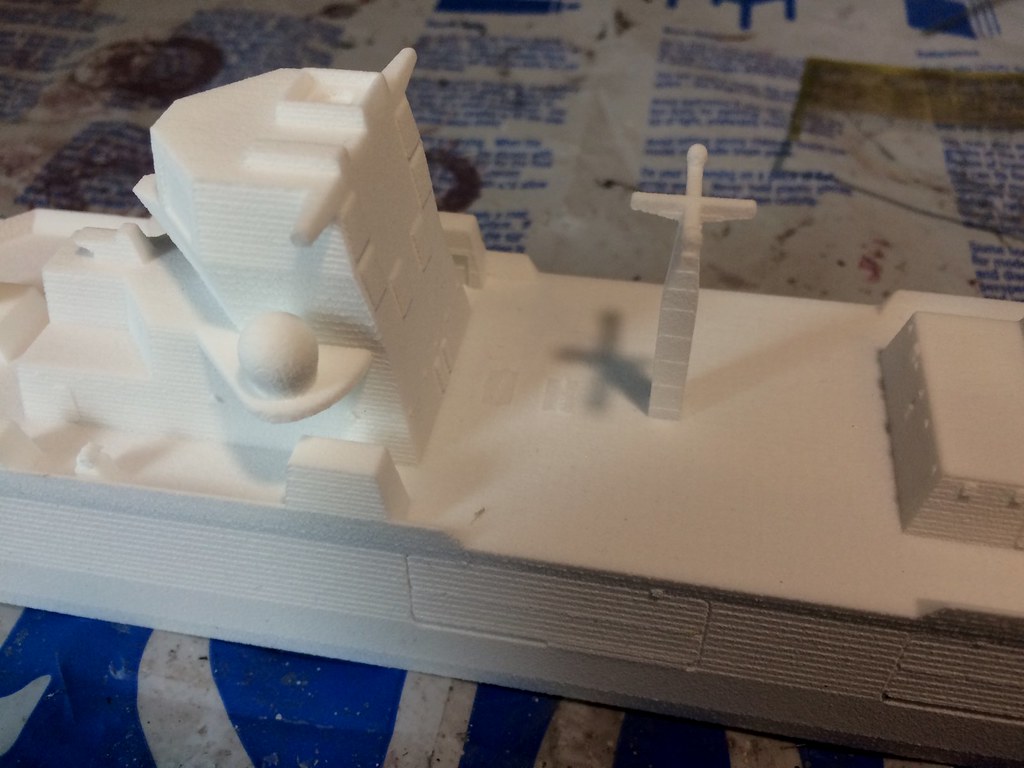
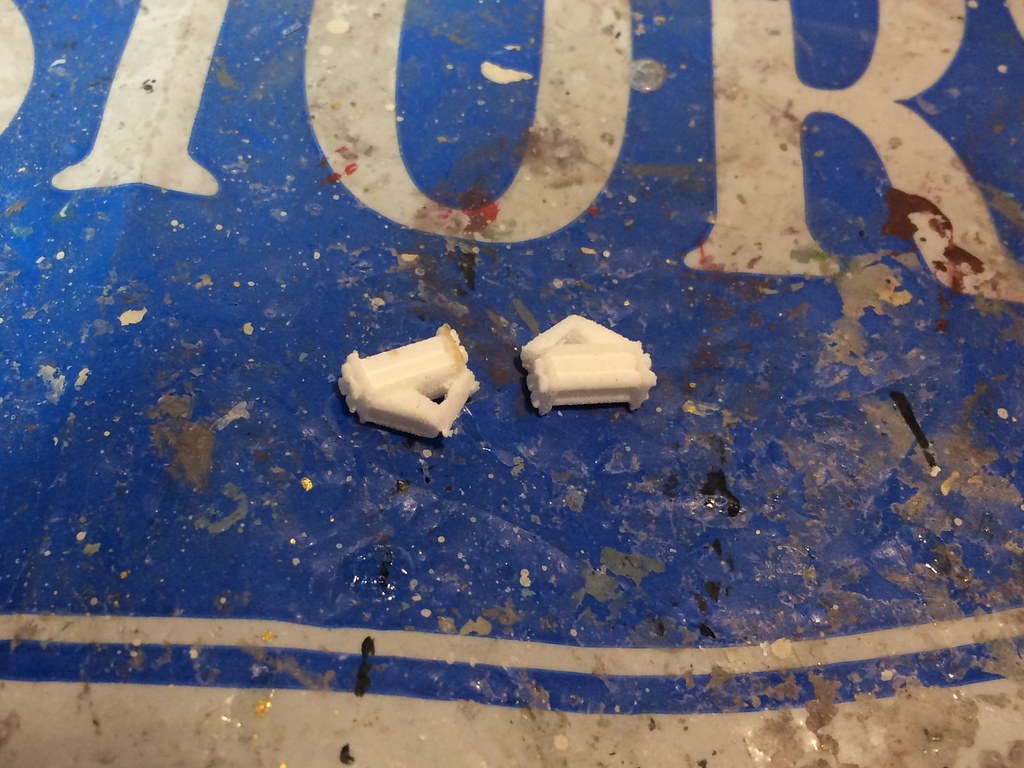
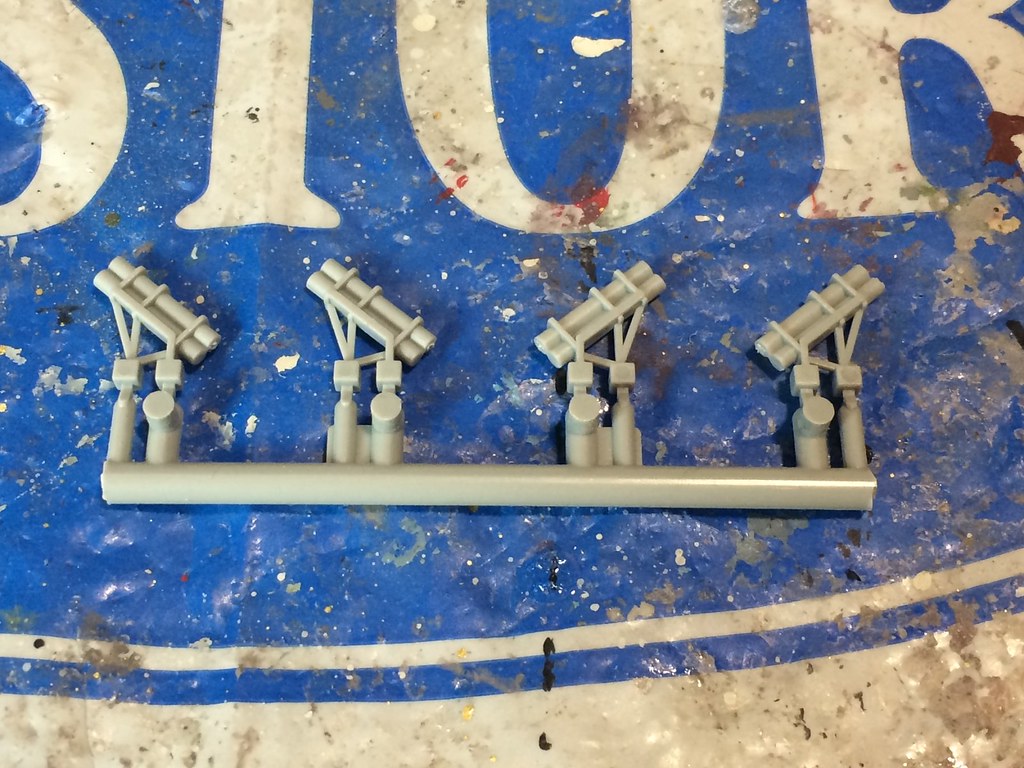
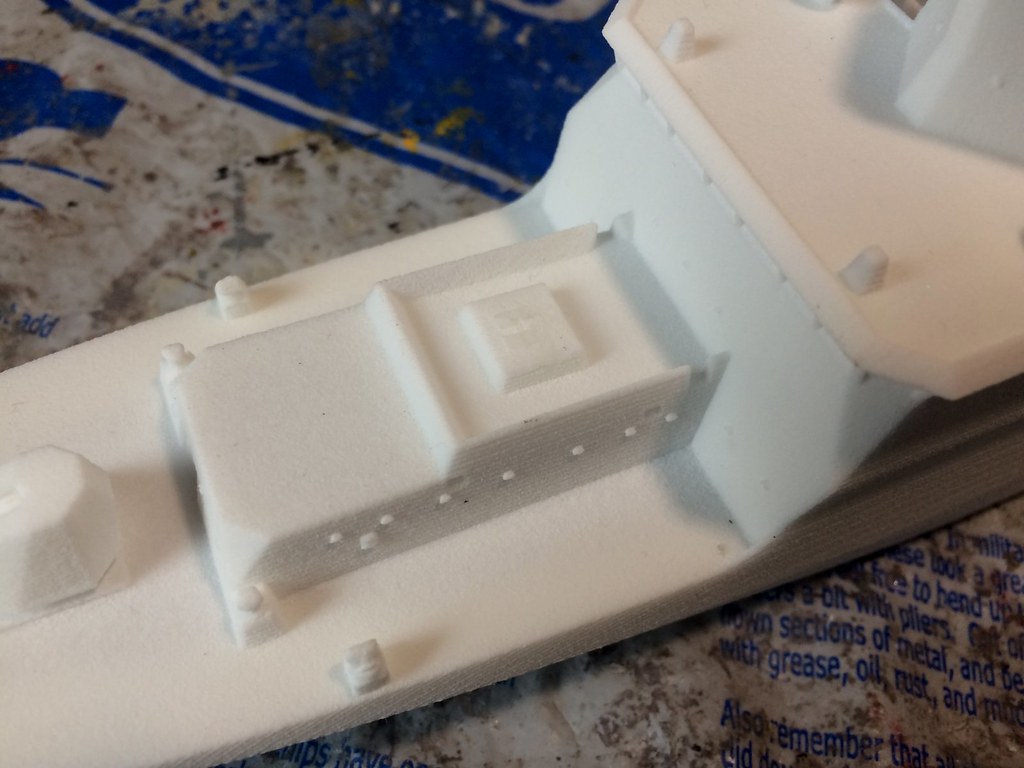
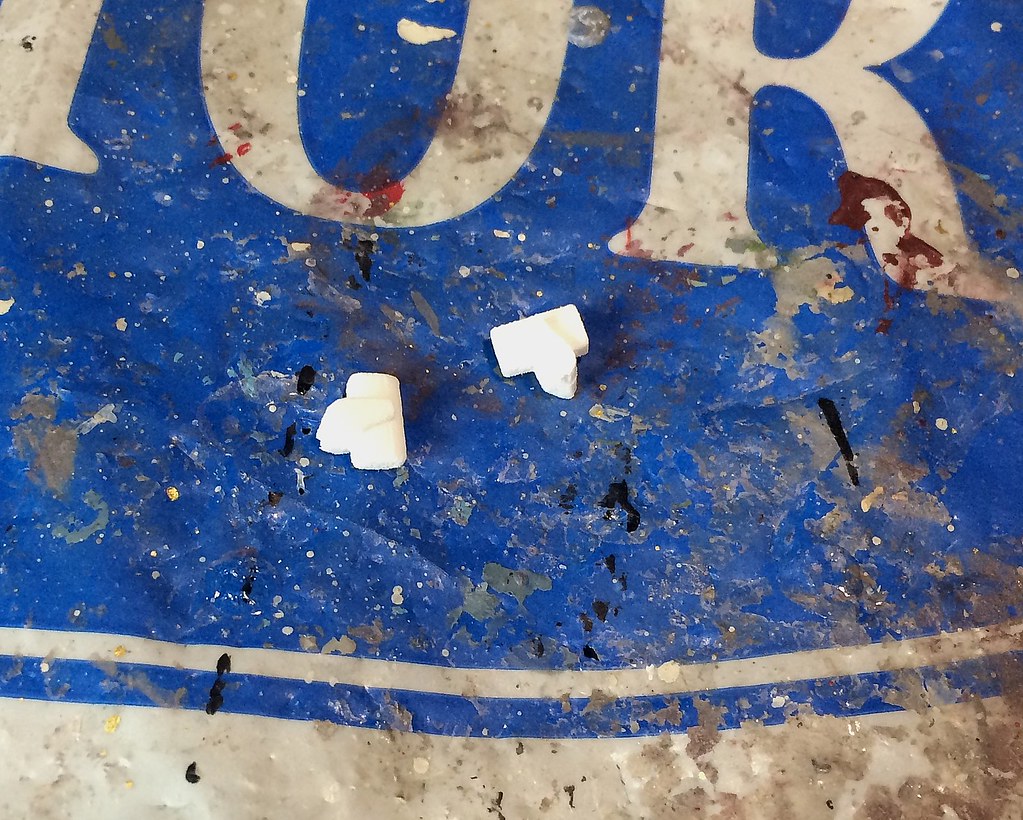
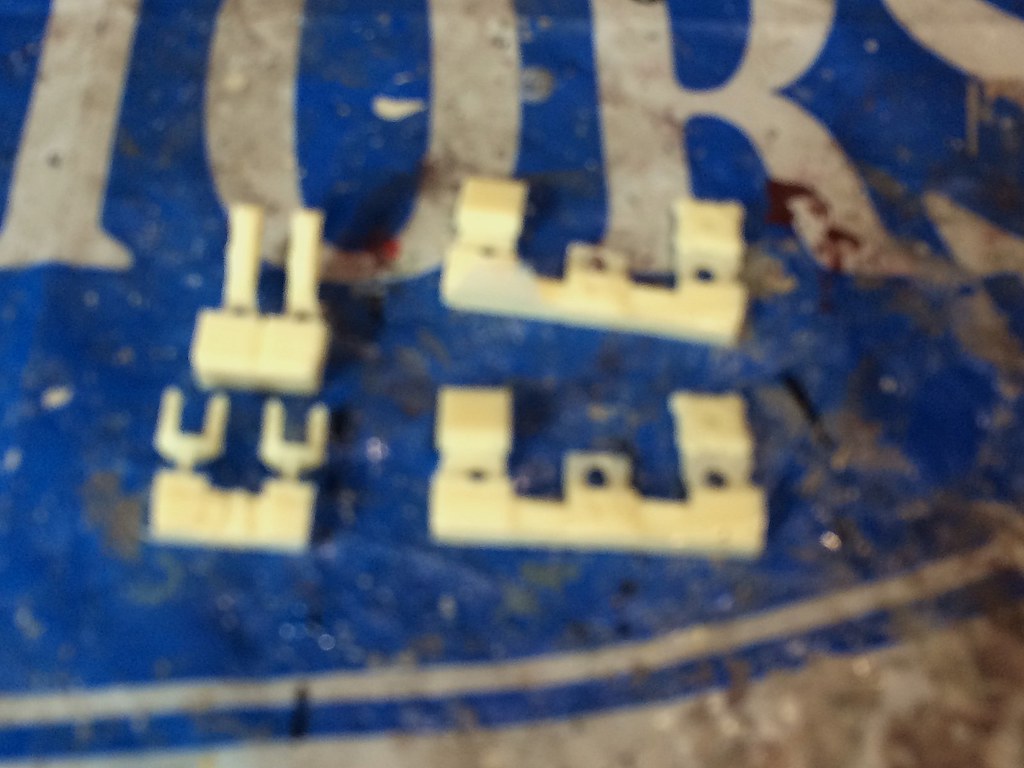

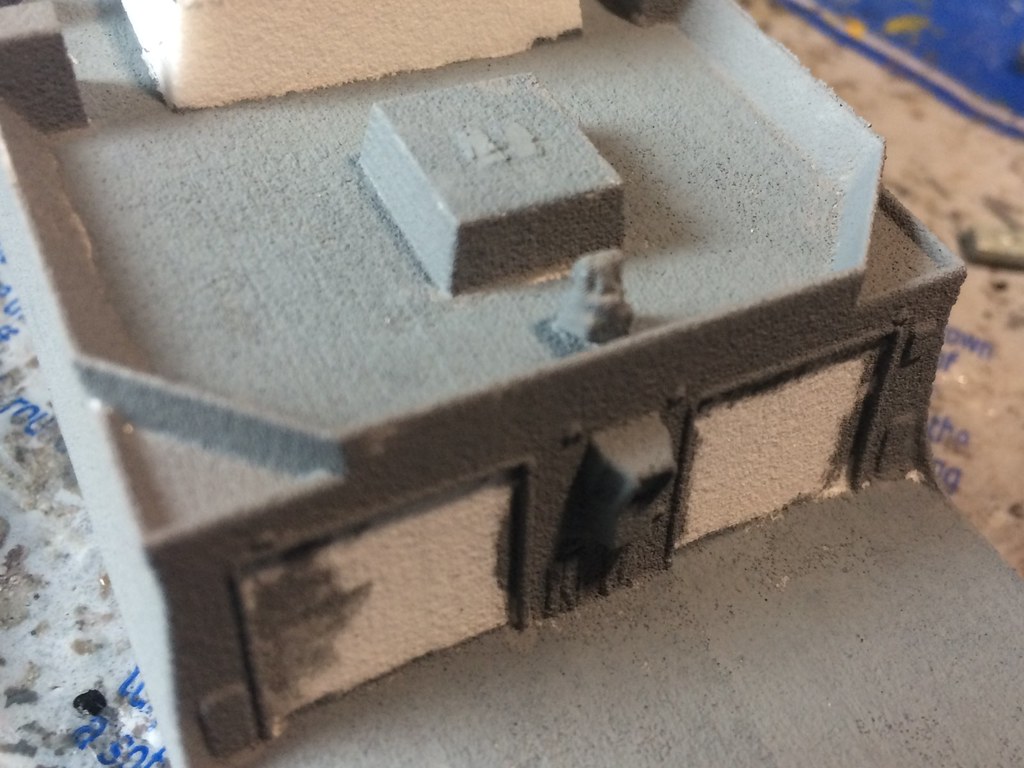
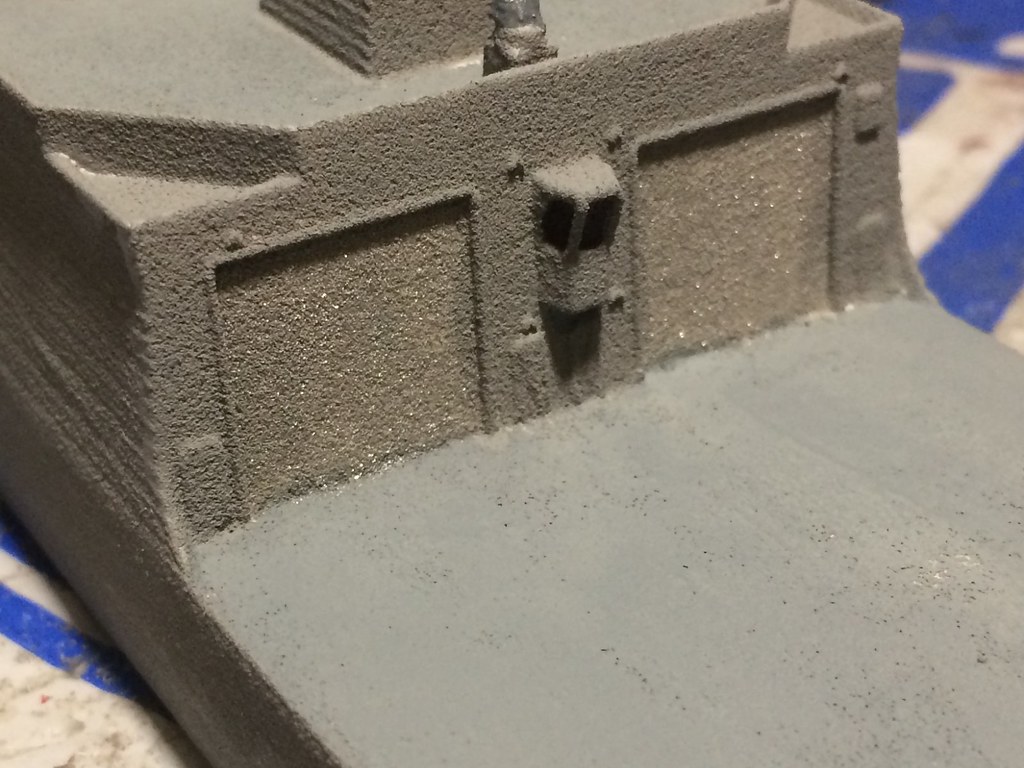
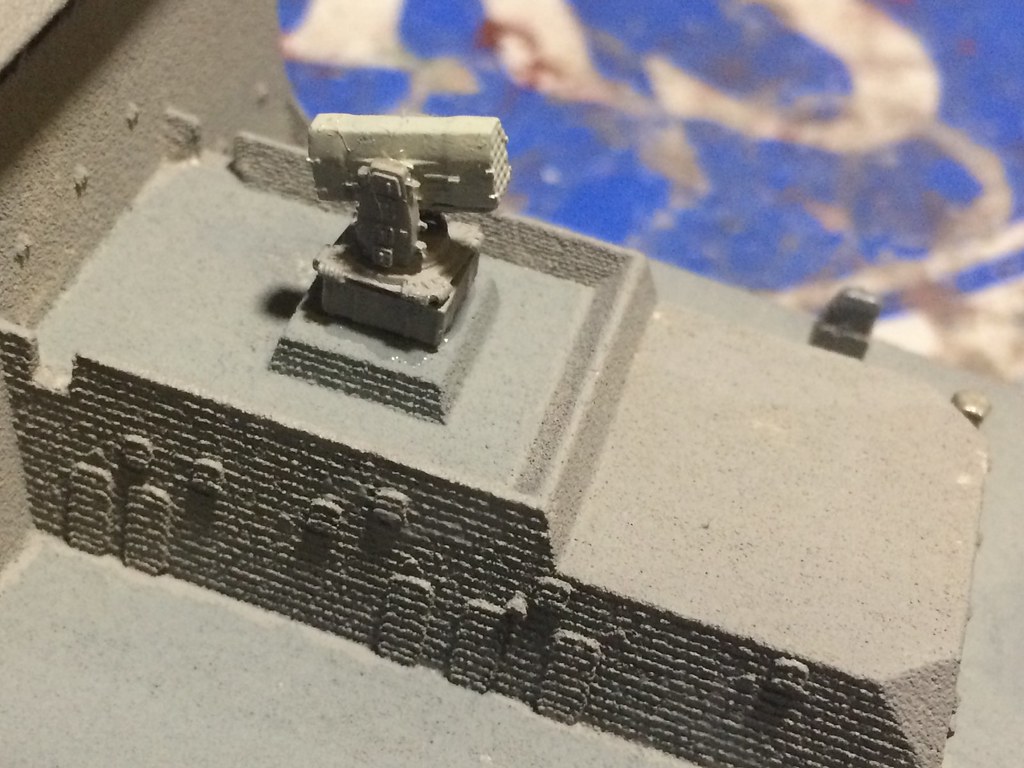

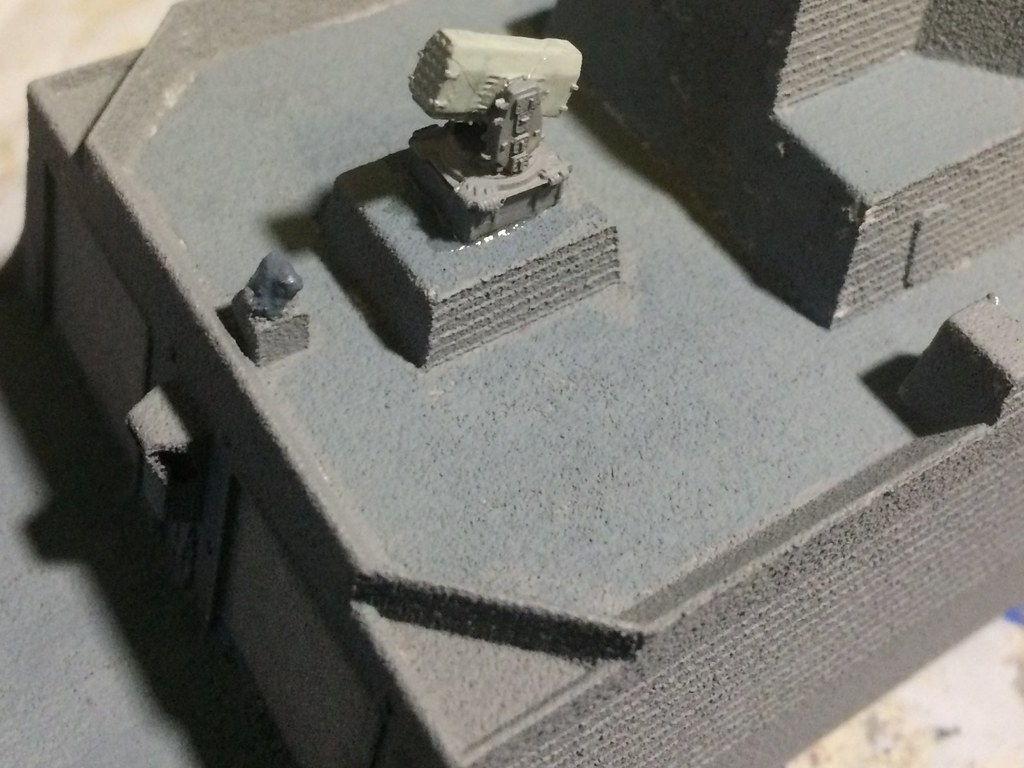
The Build - Adding initial photo etch railing and ladders and details to thebridge - March 2, 2017 At this point I decided to put the hand rail on amidships (most of the ships is built stealthy with no need for railing as they have formed the superstructure with angled sides to protect the personnel. I then added some of the detail for sensors to the main brindg/forward superstructure.
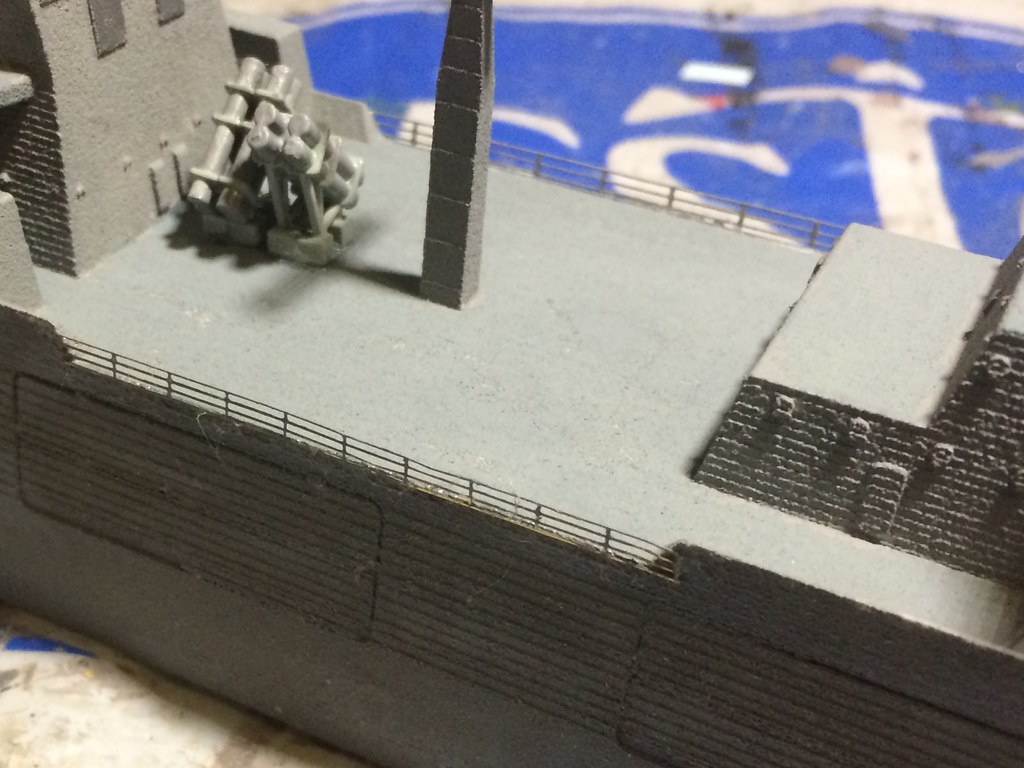
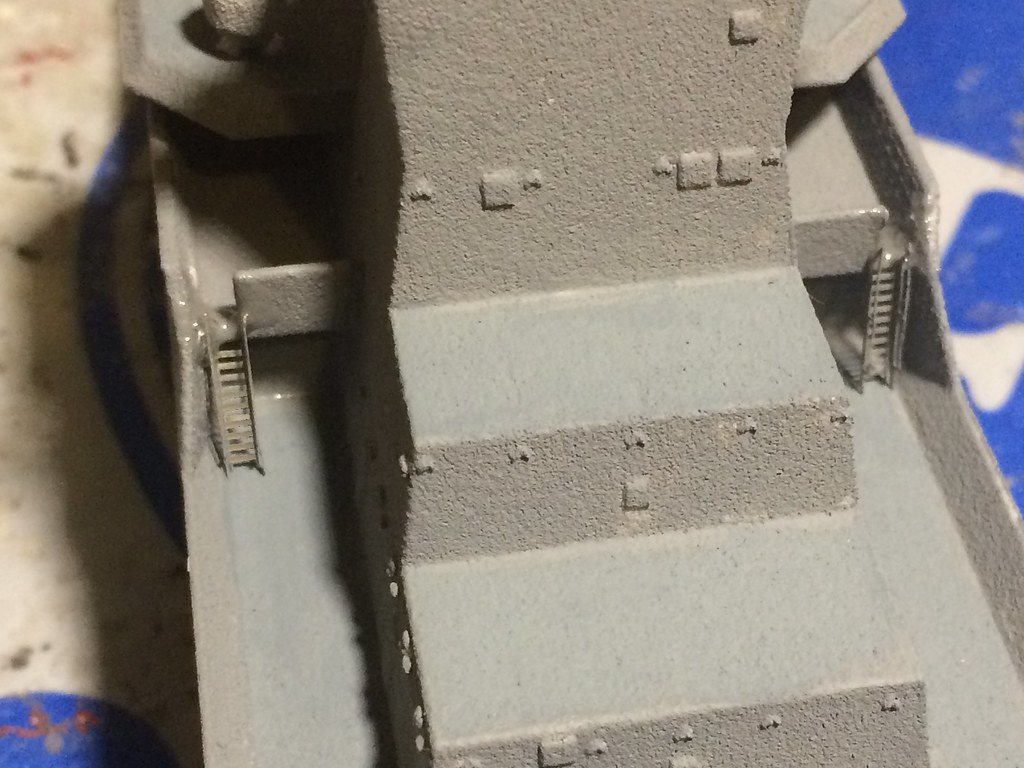
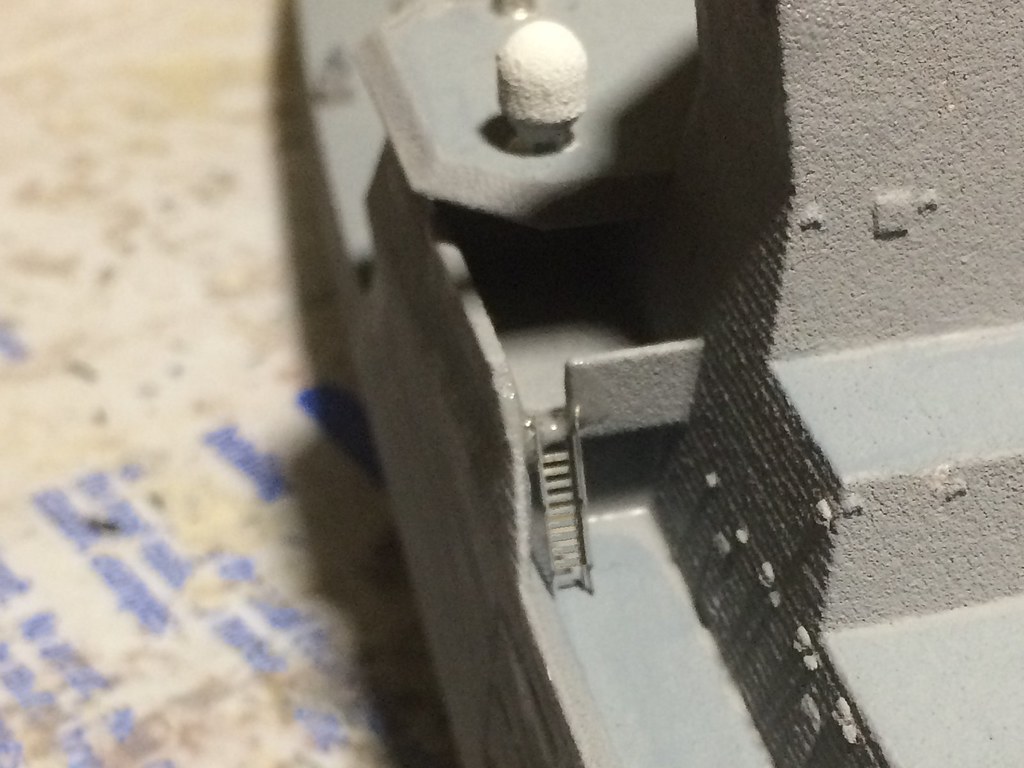
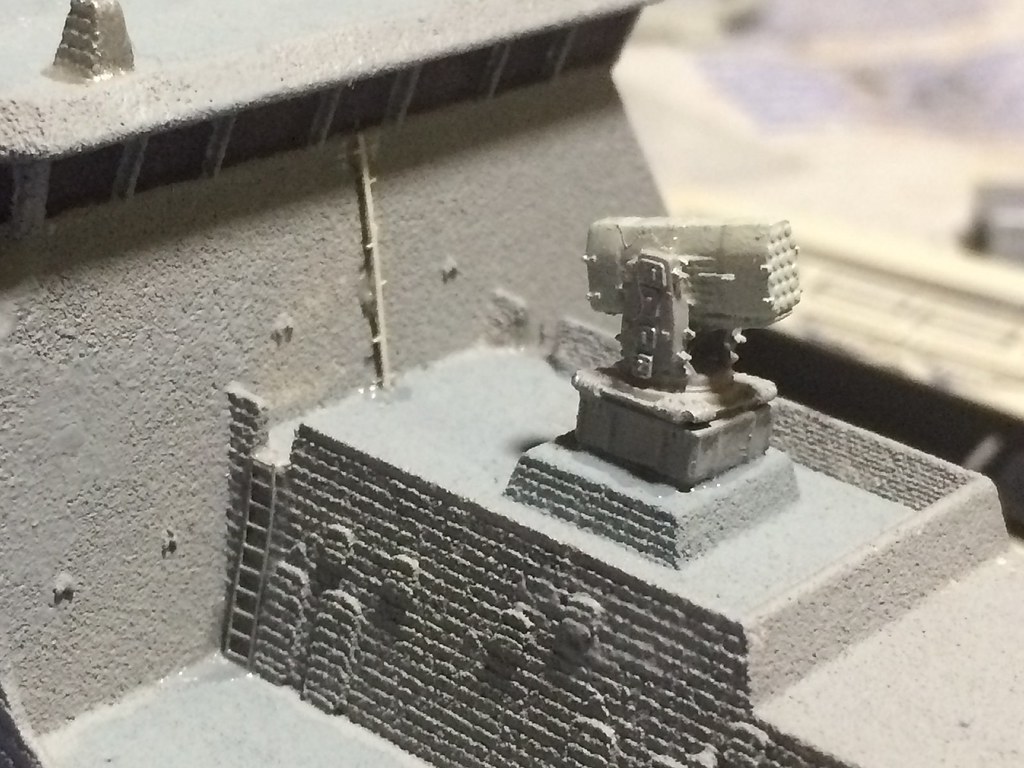
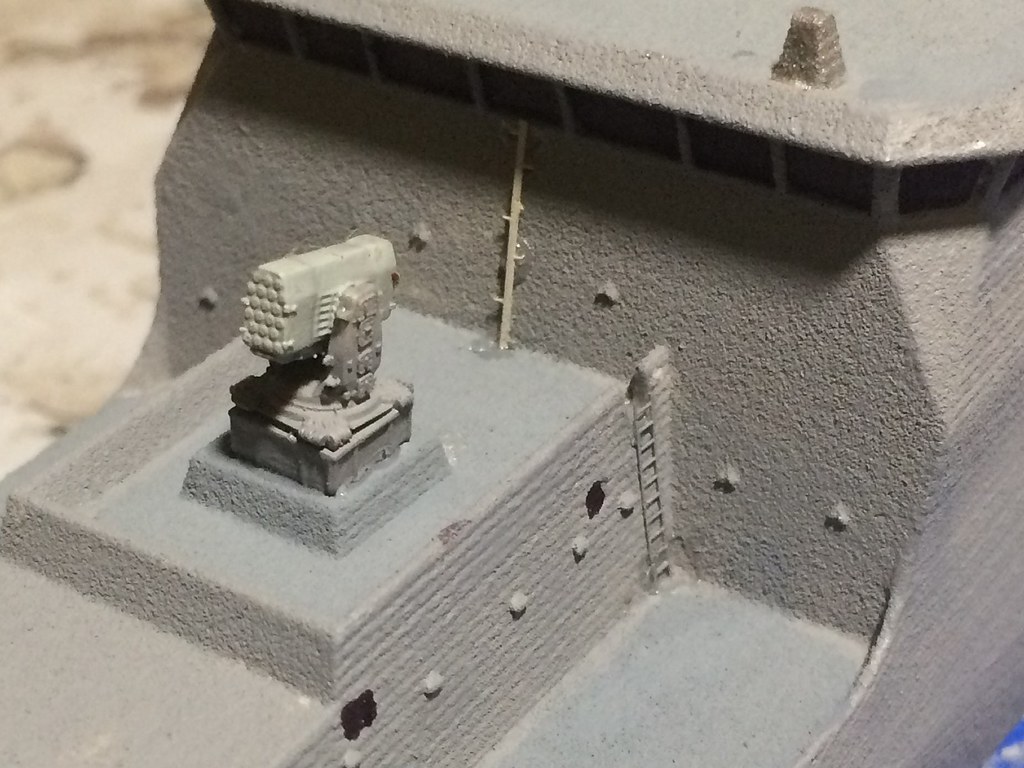
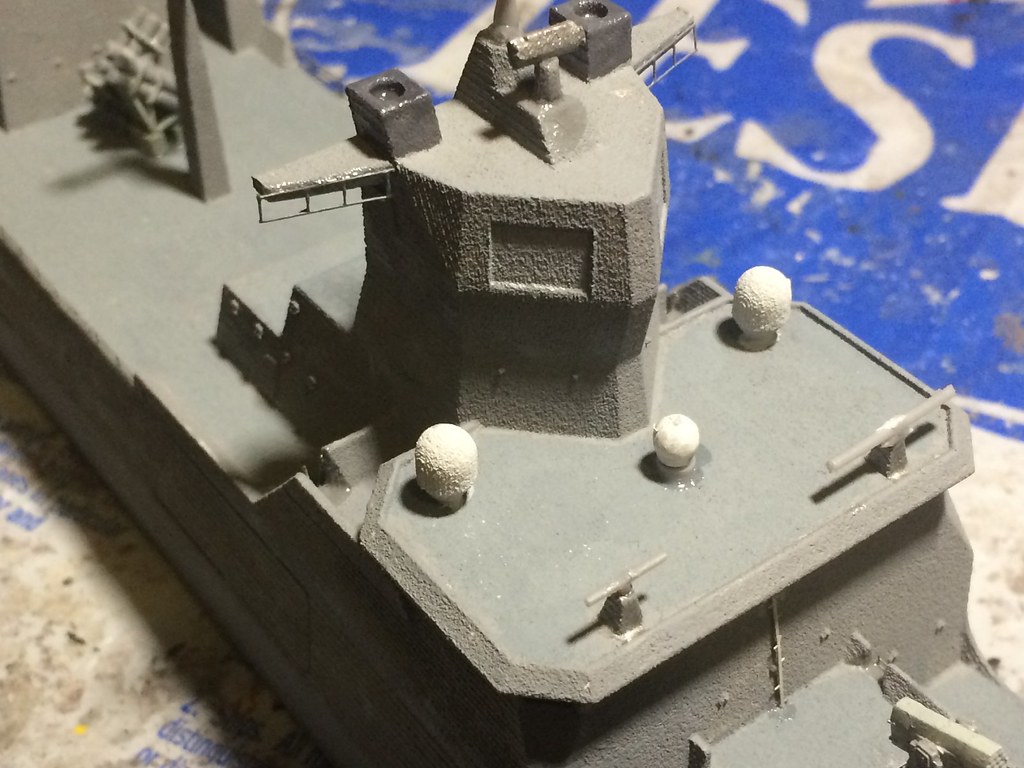
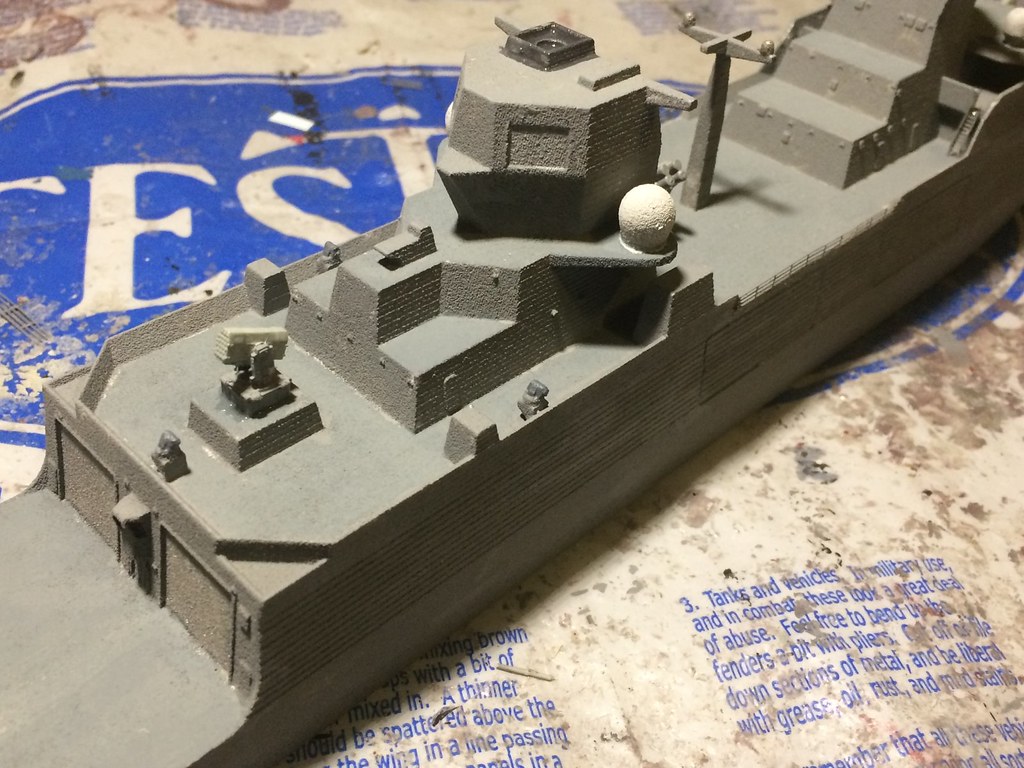
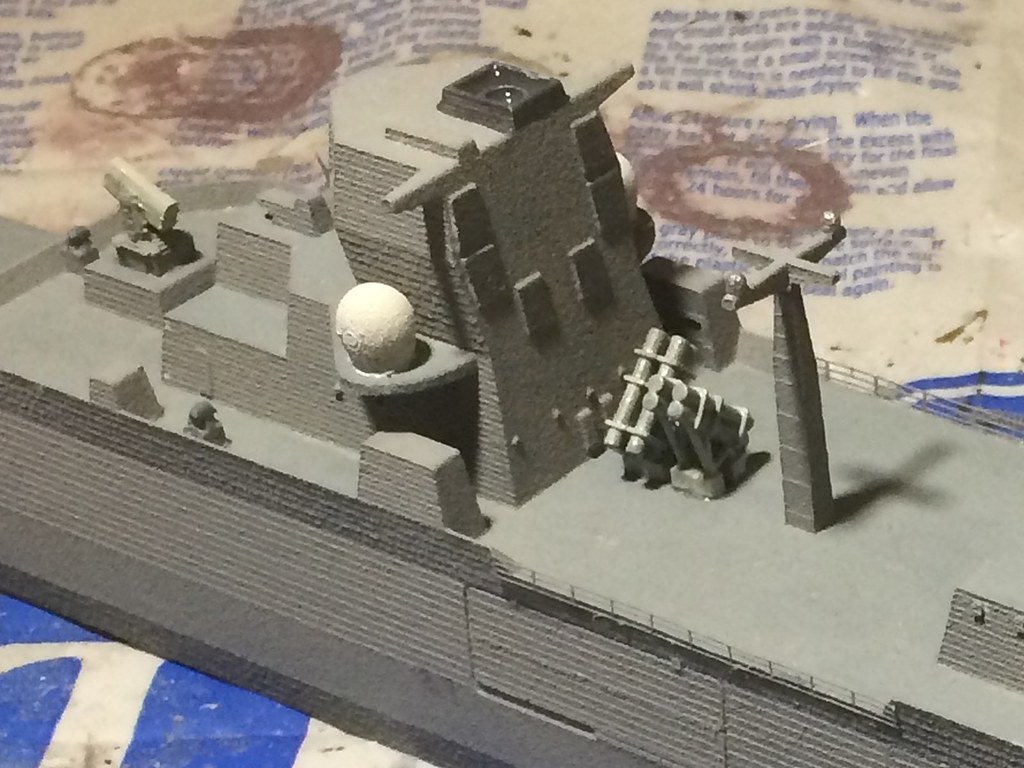
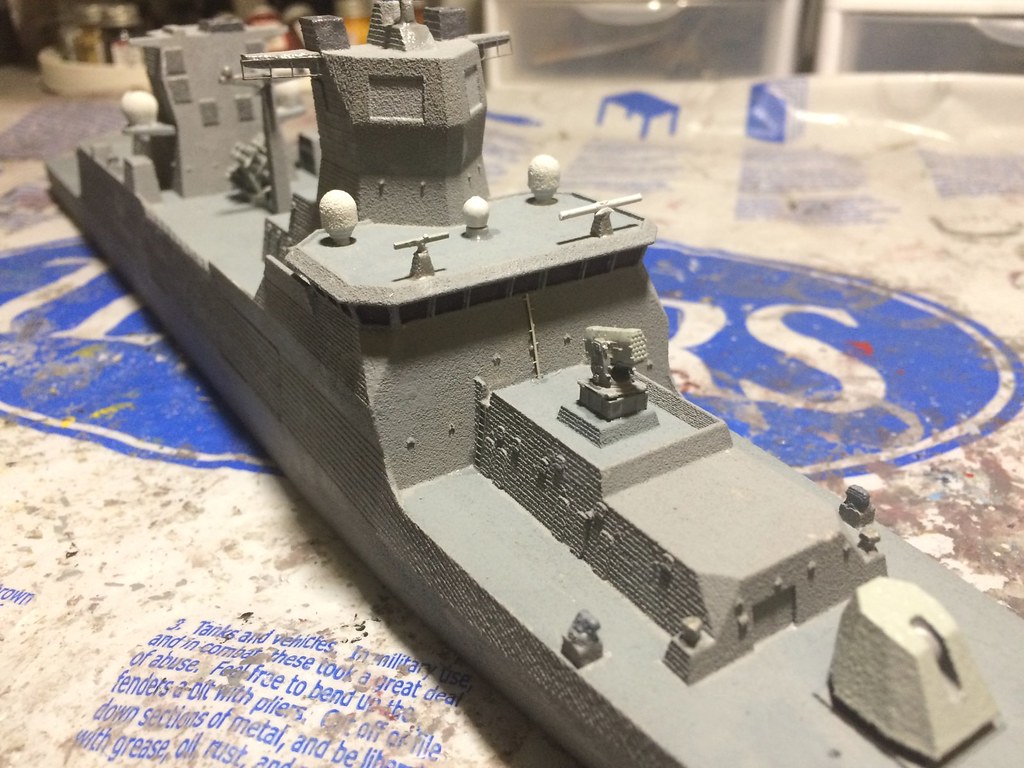

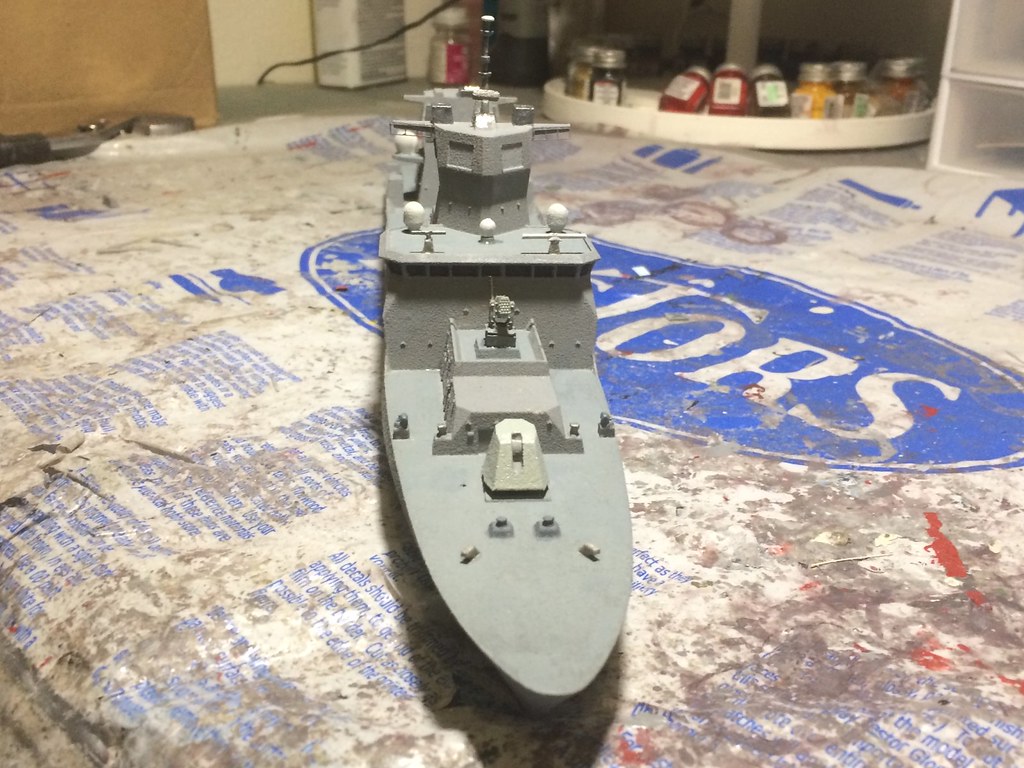
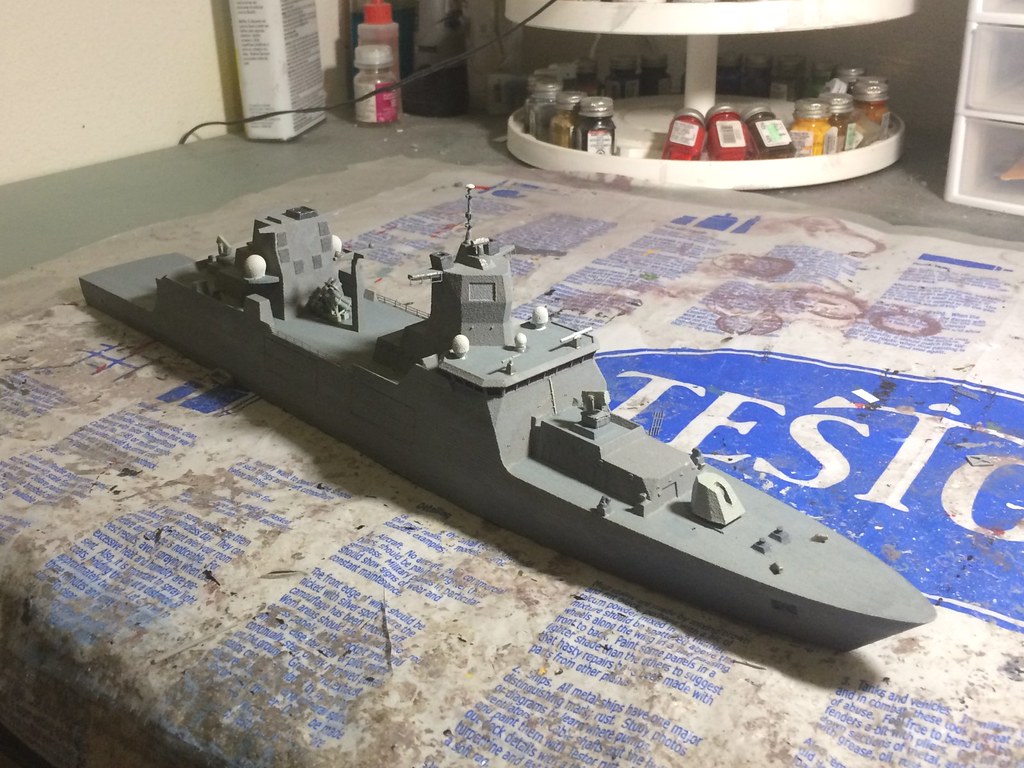
The Build - Adding helo deck and hull markings, adding more detail to aft superstructure and other areas, incuding more weapon systesm, photo etch railing, sensors, etc. - March 4, 2017 At this point I was ready to add the markings to the ship. I used left over decals from the Type 122 model I buuilt to construct the F222, and then other spare decals to form the helo landing pad. I then added many details including 25mm auti guns ammidships (for the 27mm guns carried), the gun barrels for the five 12.7 auto-cannons, and various sensors and equipment around the vessel, following the pcitures of the vessel that are available to rither use spare parts or scratch build the, Quite a bit in all of this, and here's how it went:
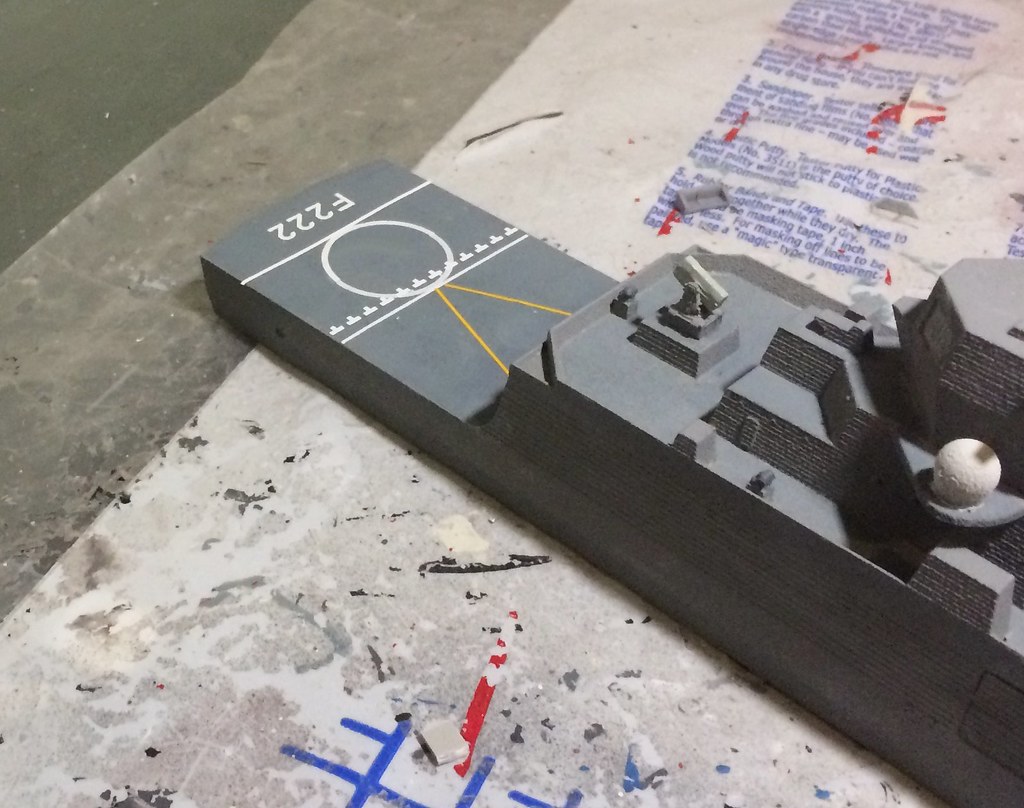
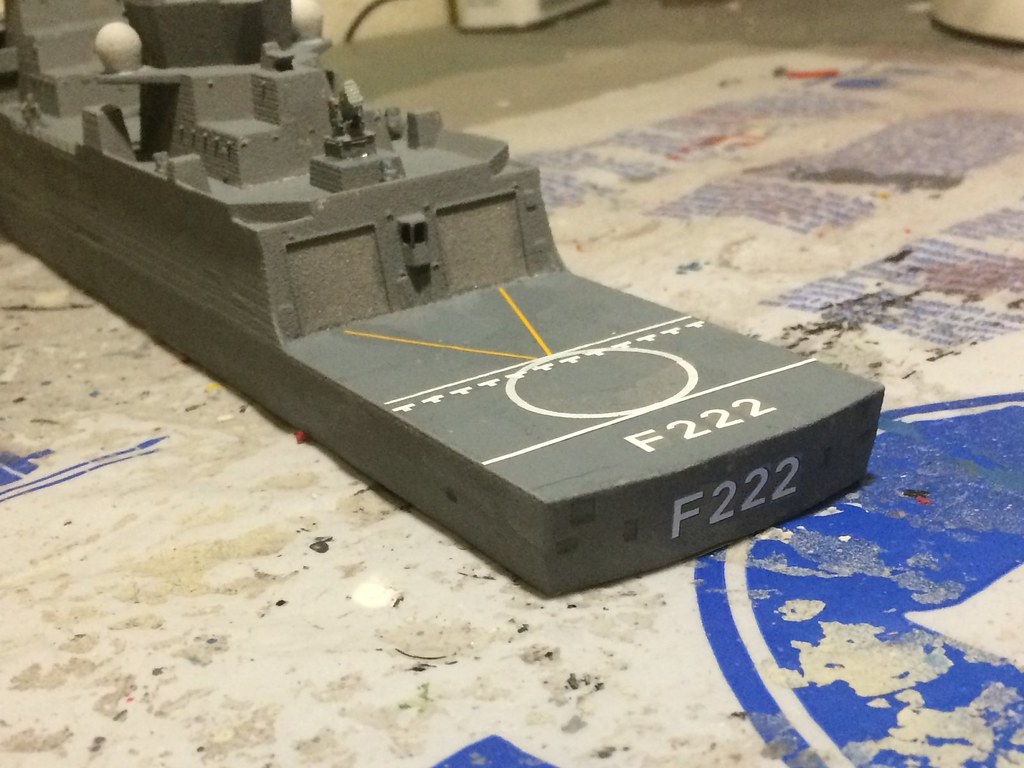
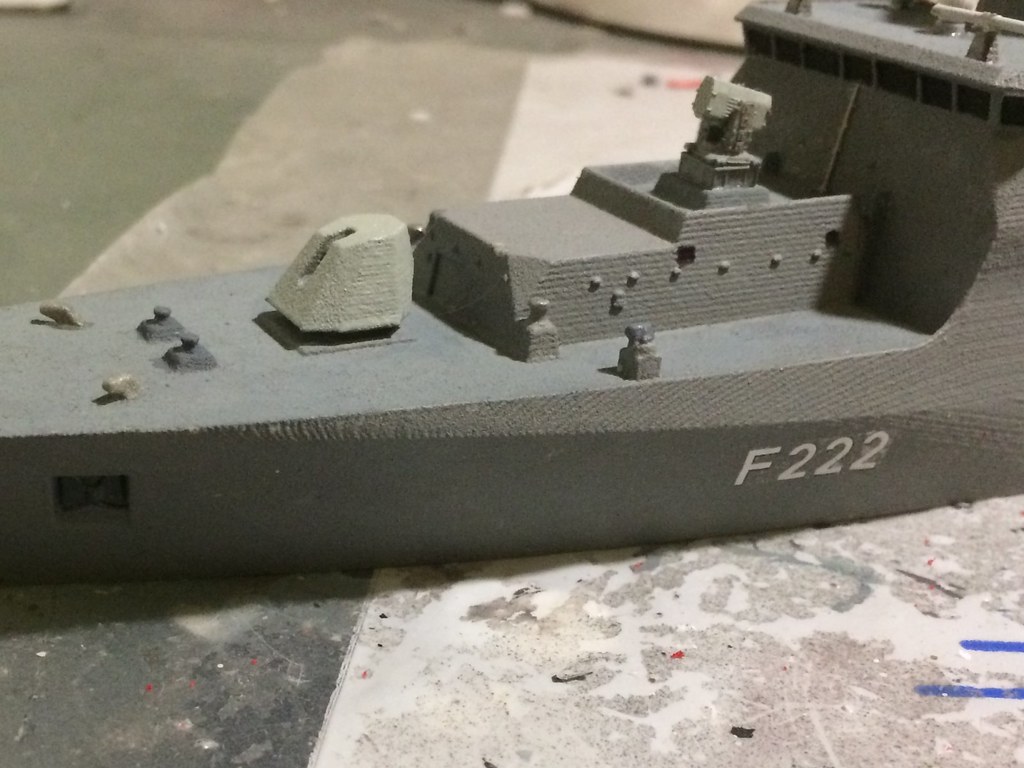
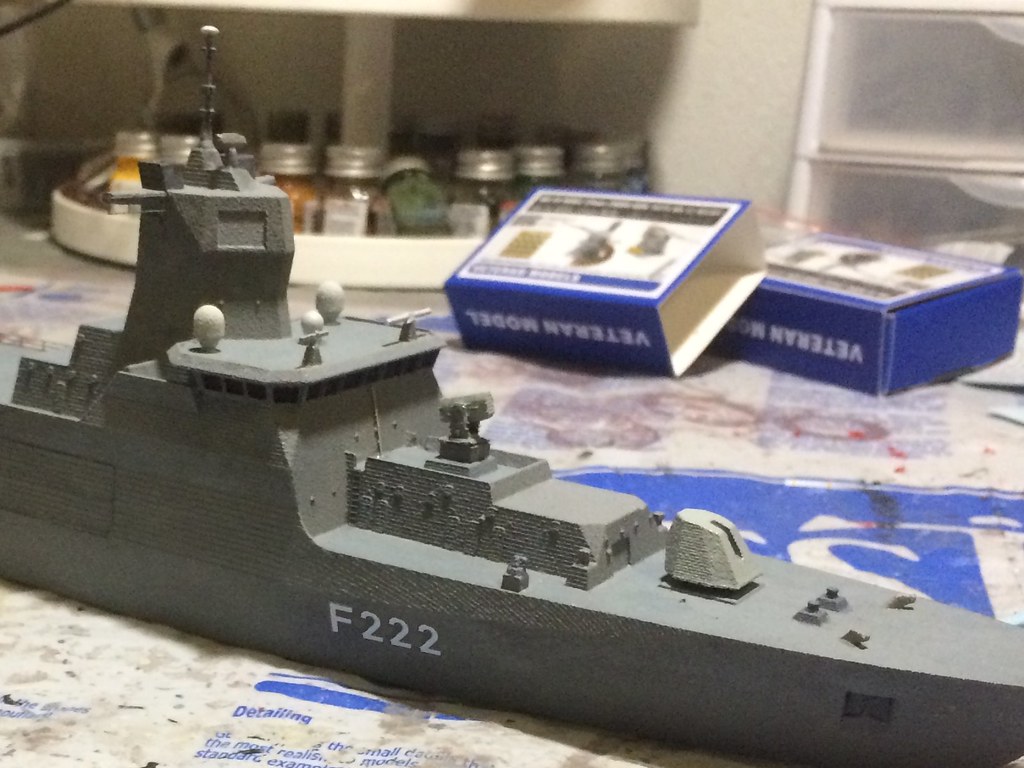
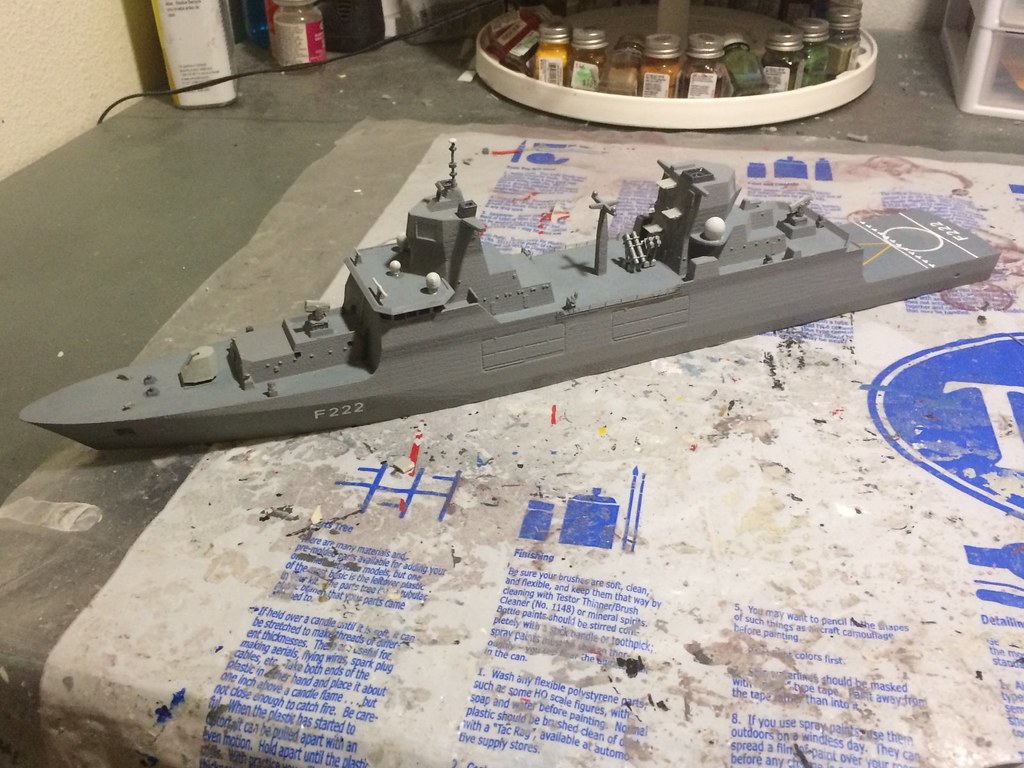
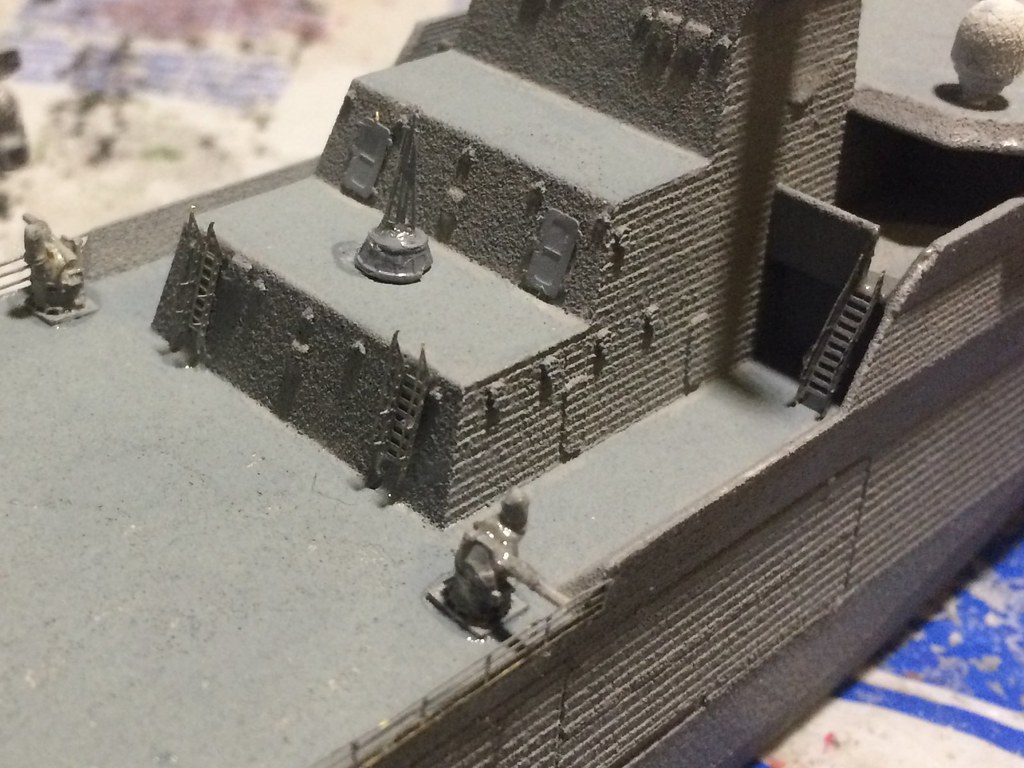
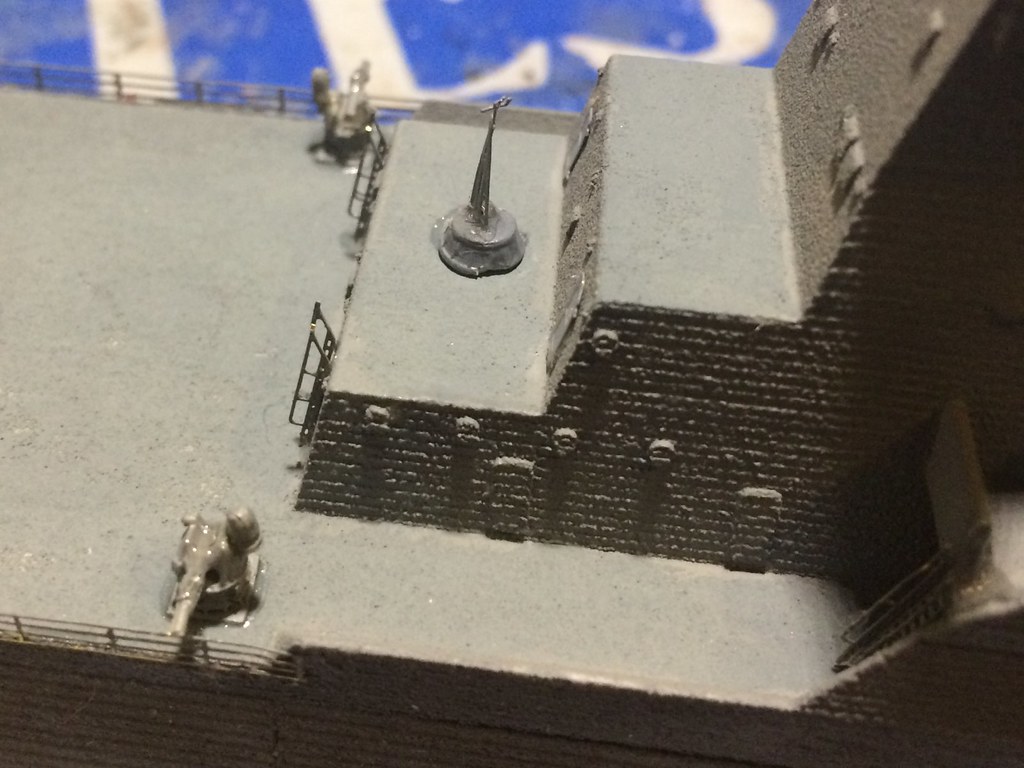
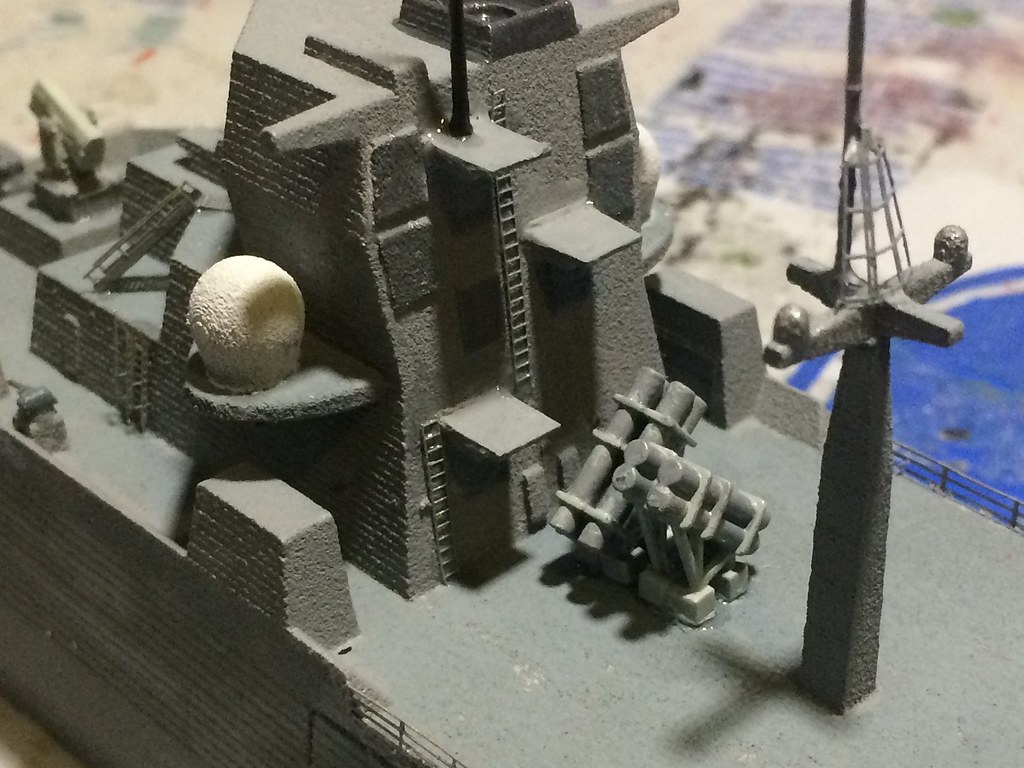
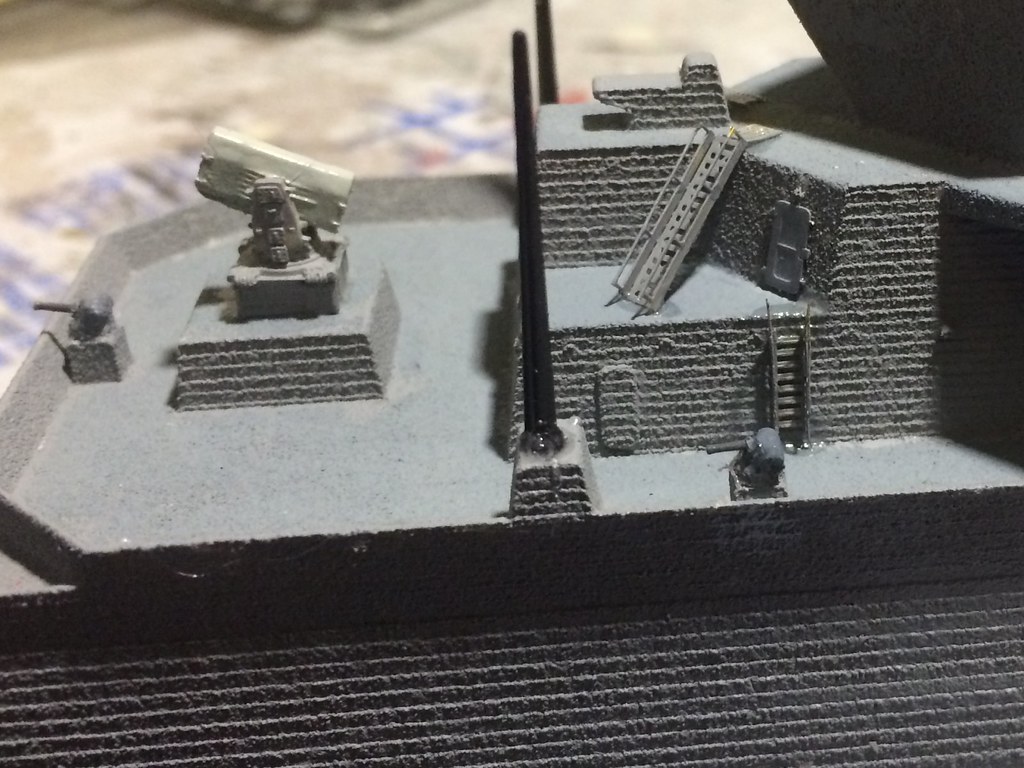
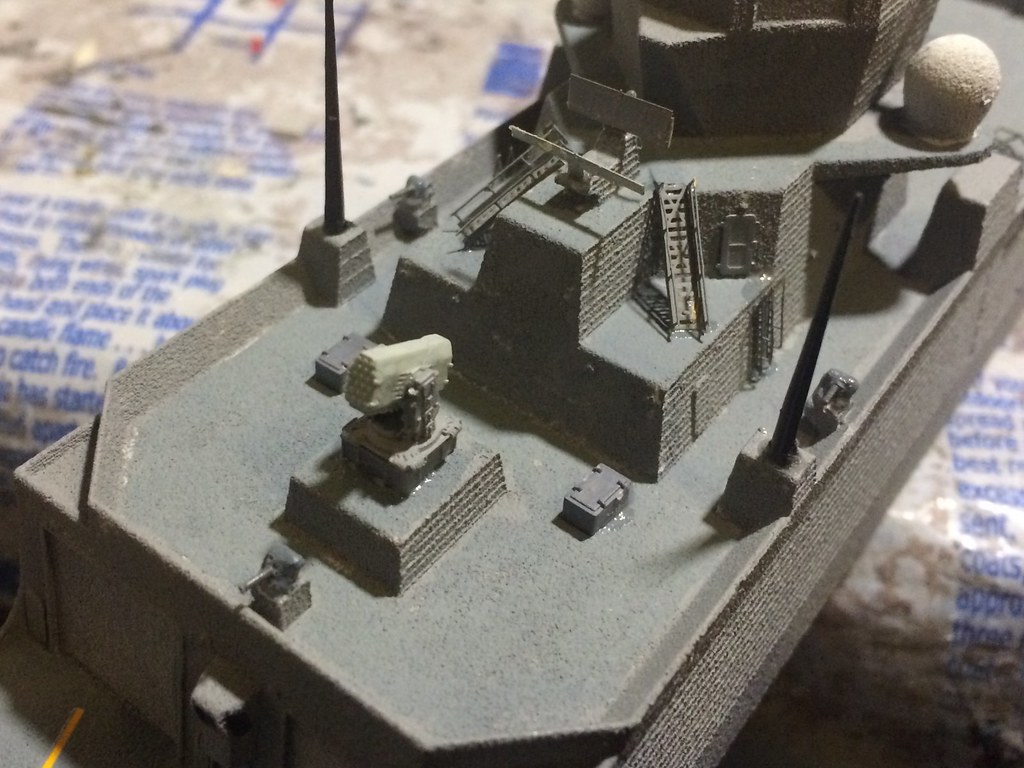

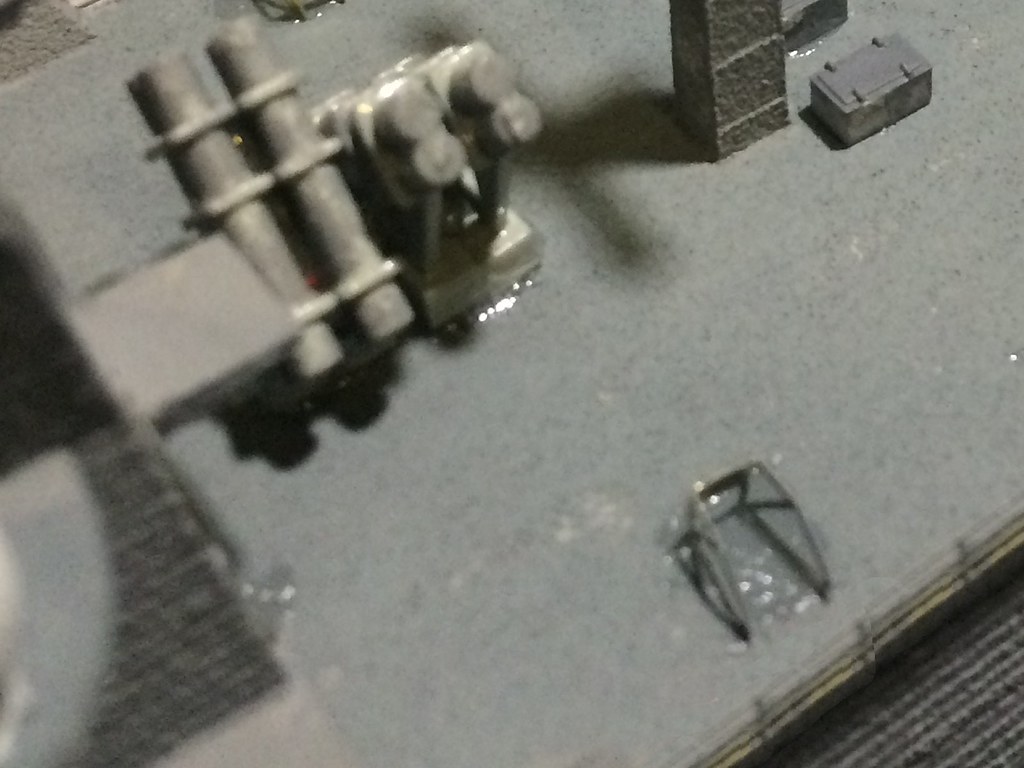

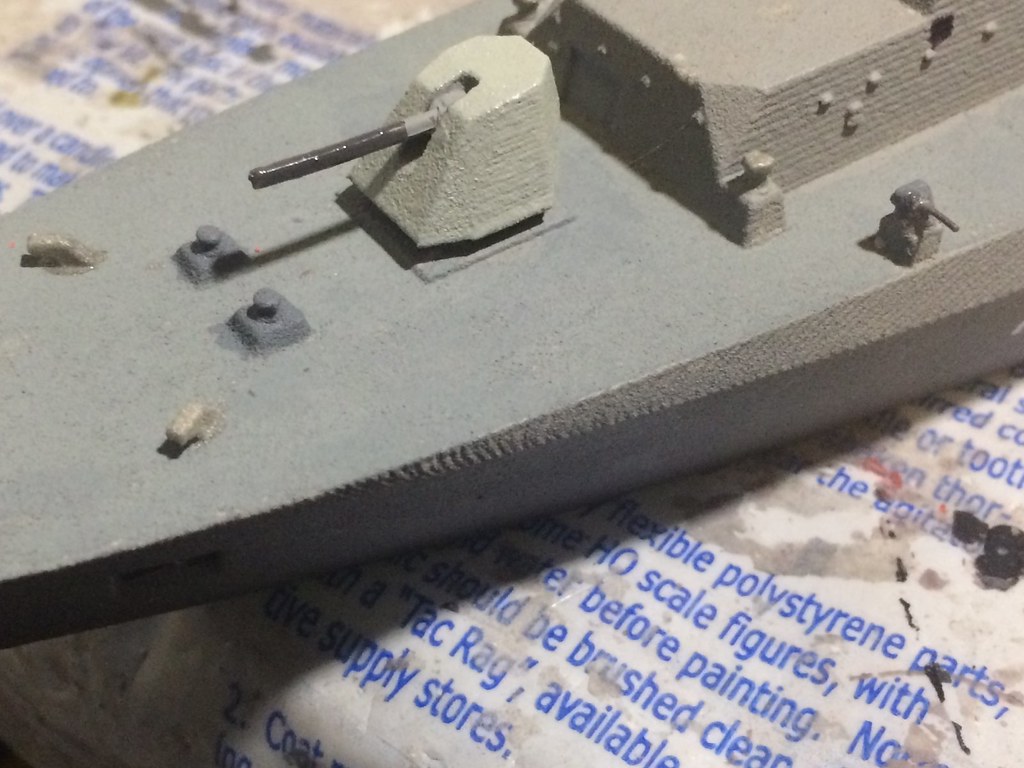
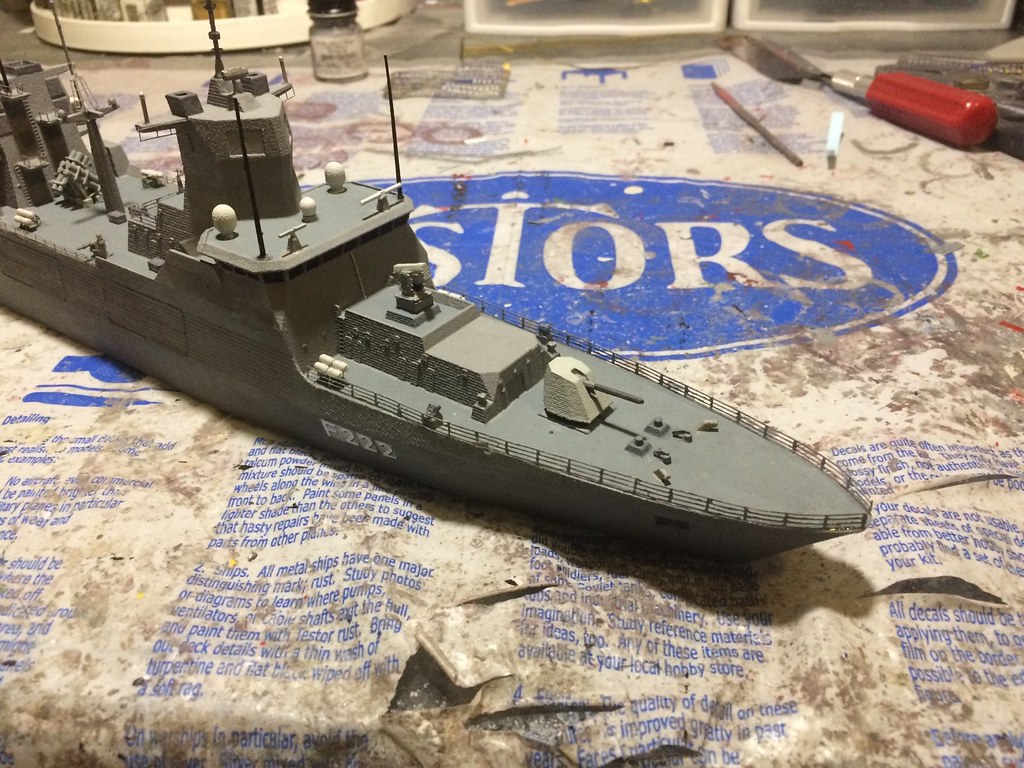
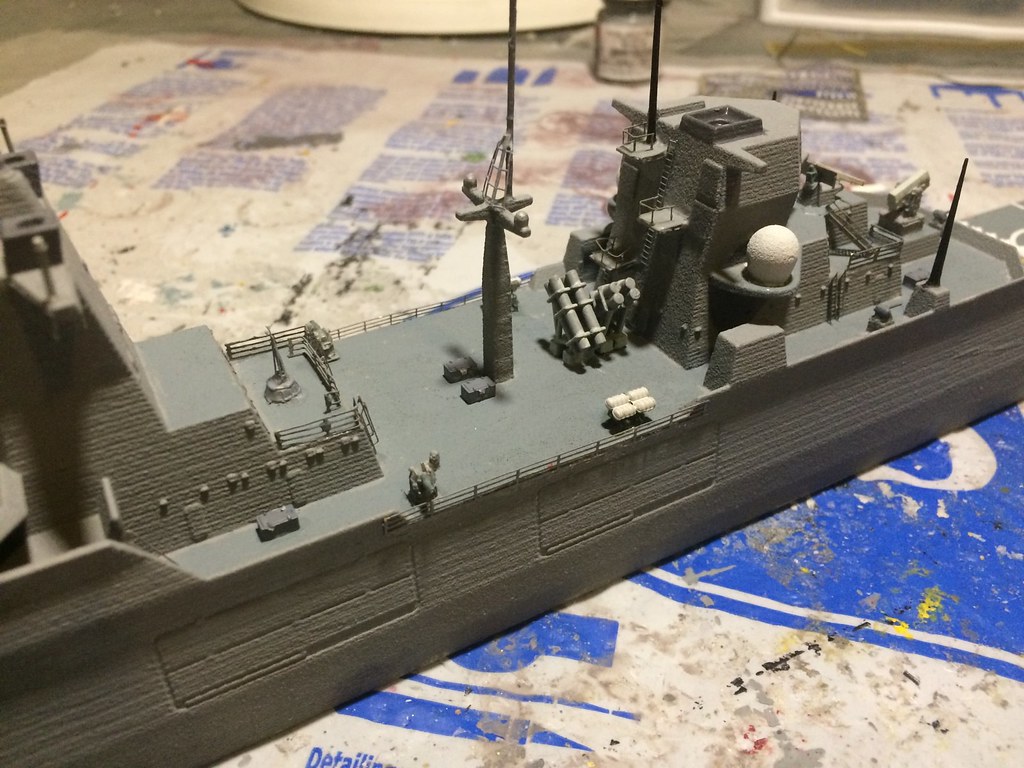
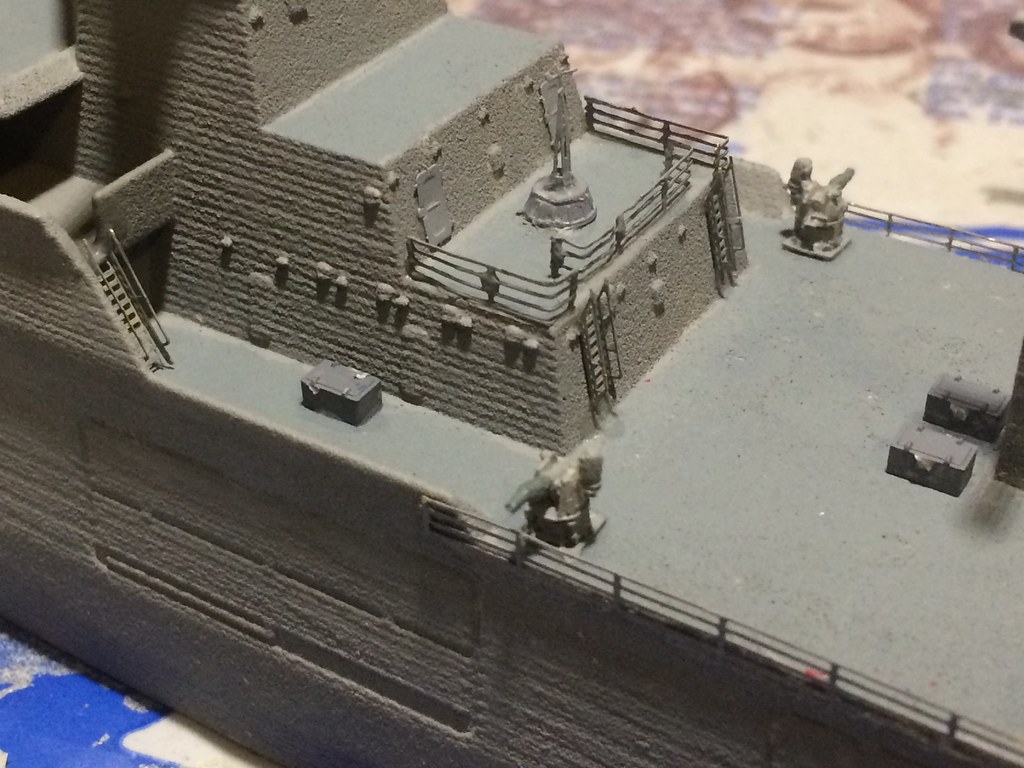
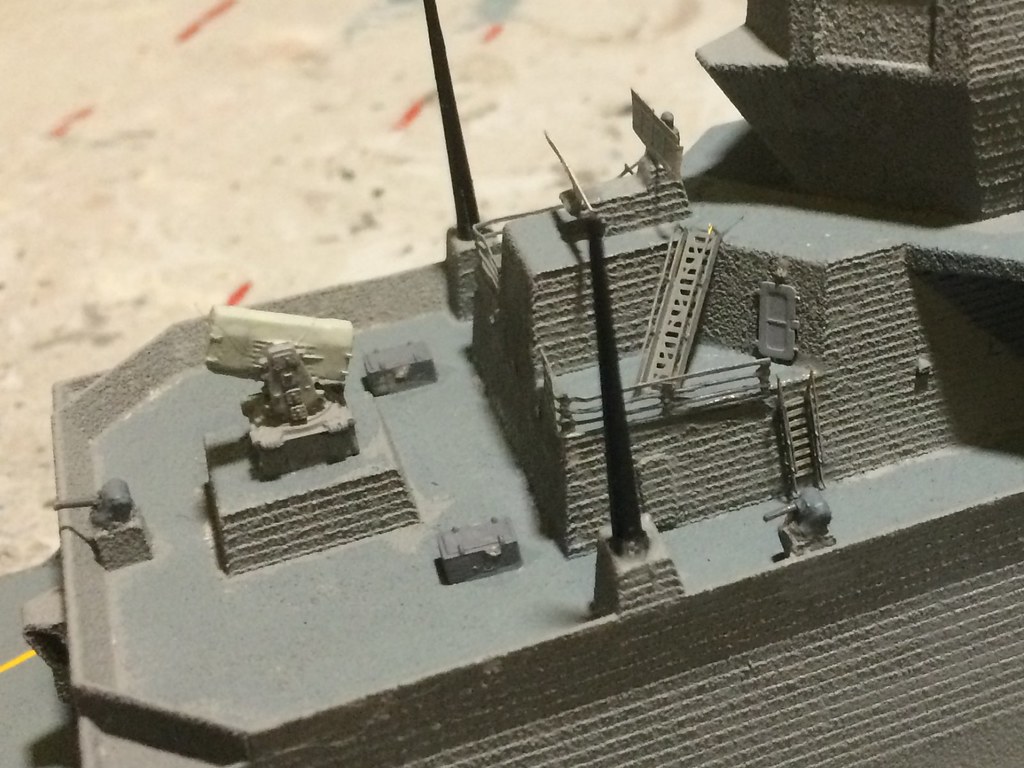
The Build - More photo etch railing, including the helo landing pad, and added the non-remote 12.7 machine guns as well as decoy launchers and life rafts - March 6, 2017 Ai then built the helo pad netting and completed adding photo etch railing and ladders, and added the 12.7mm (.50 ca) non-remote controlled machine guns. Here's how that went in finishing out the detailing:
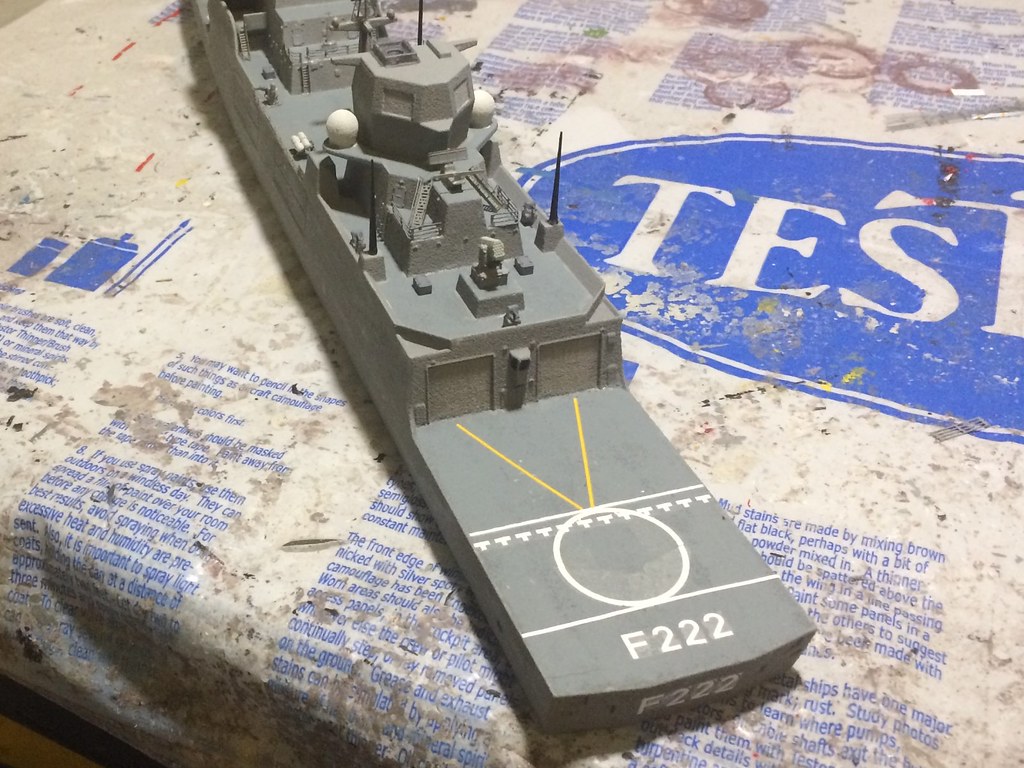
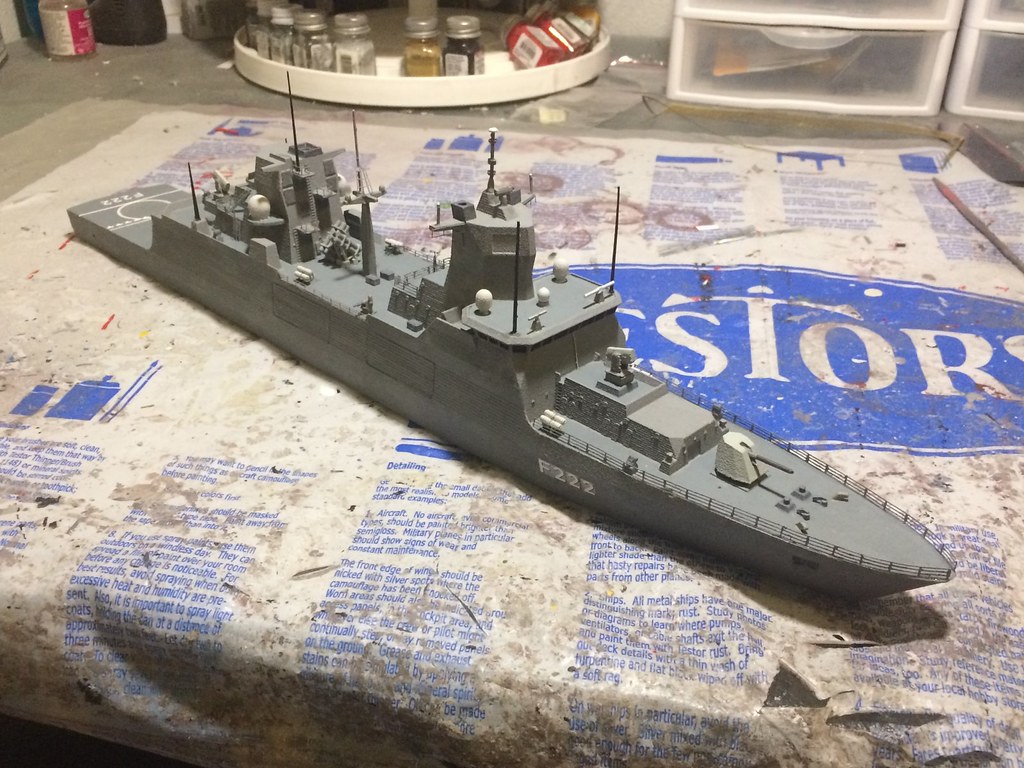
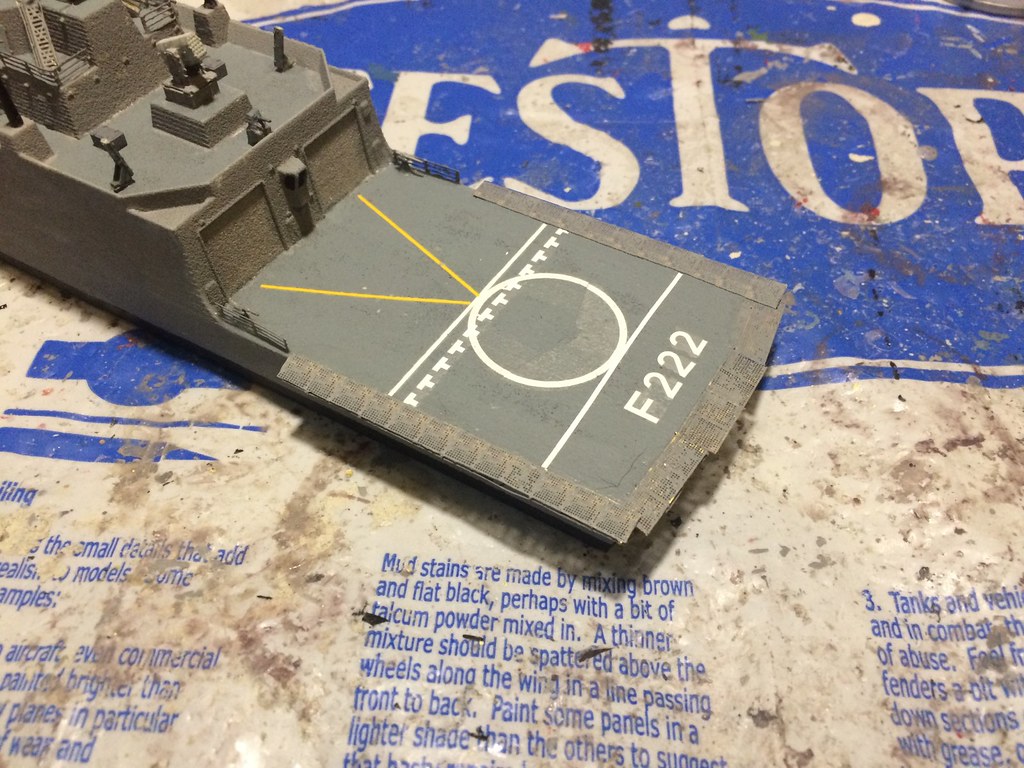
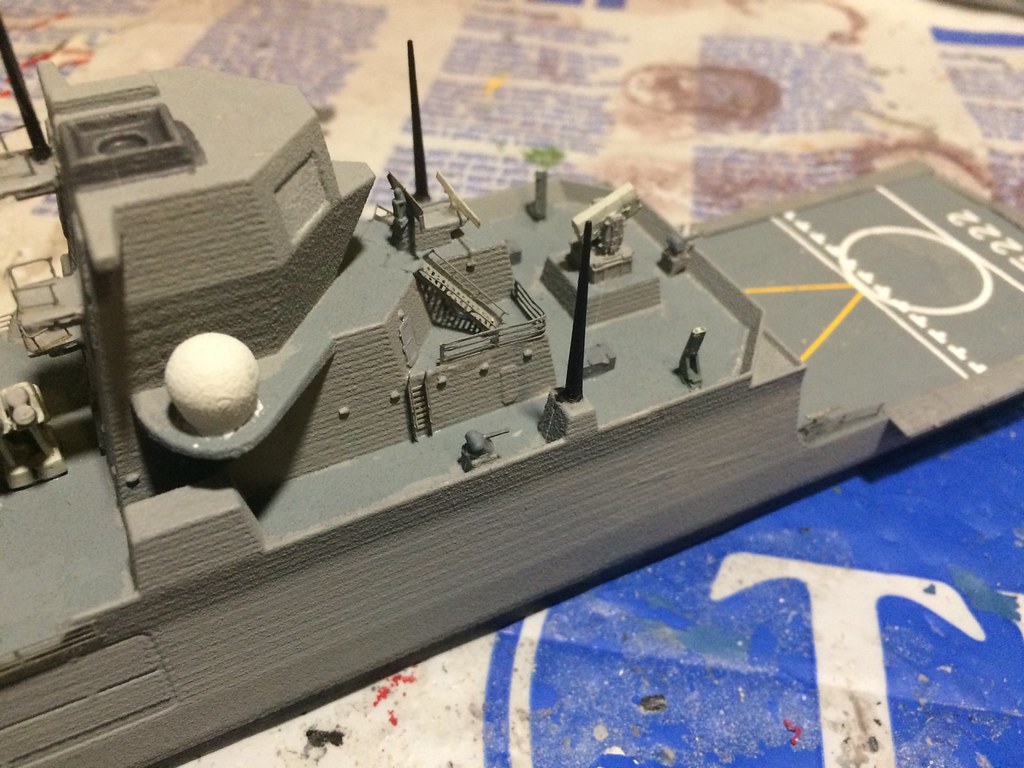
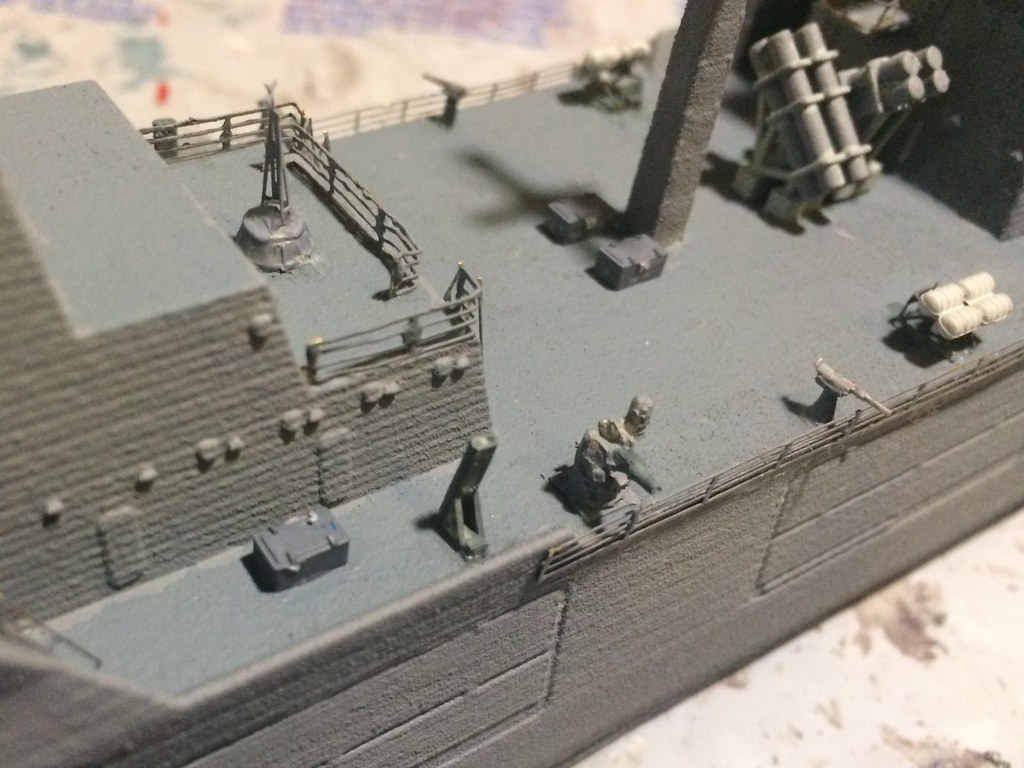
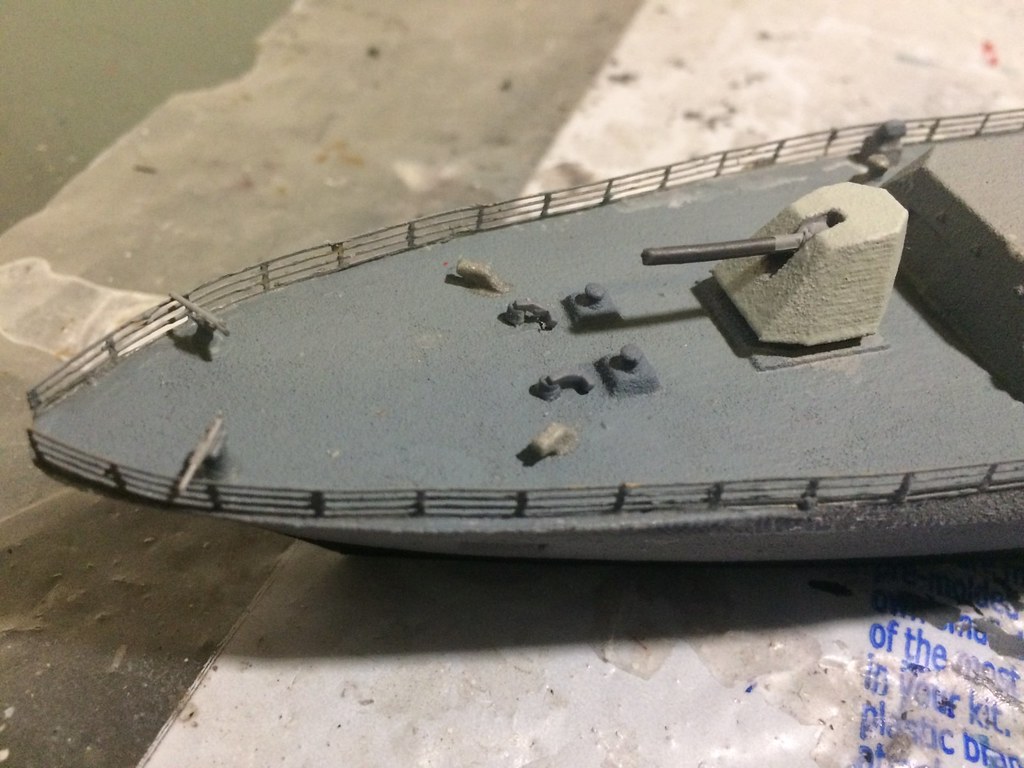
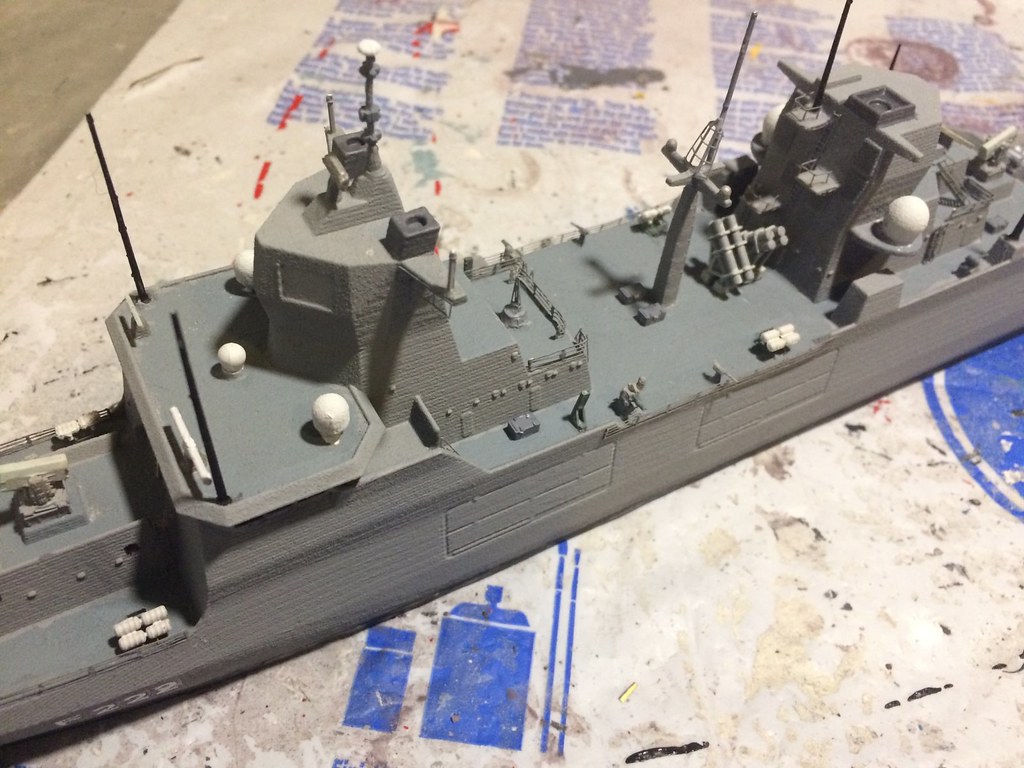
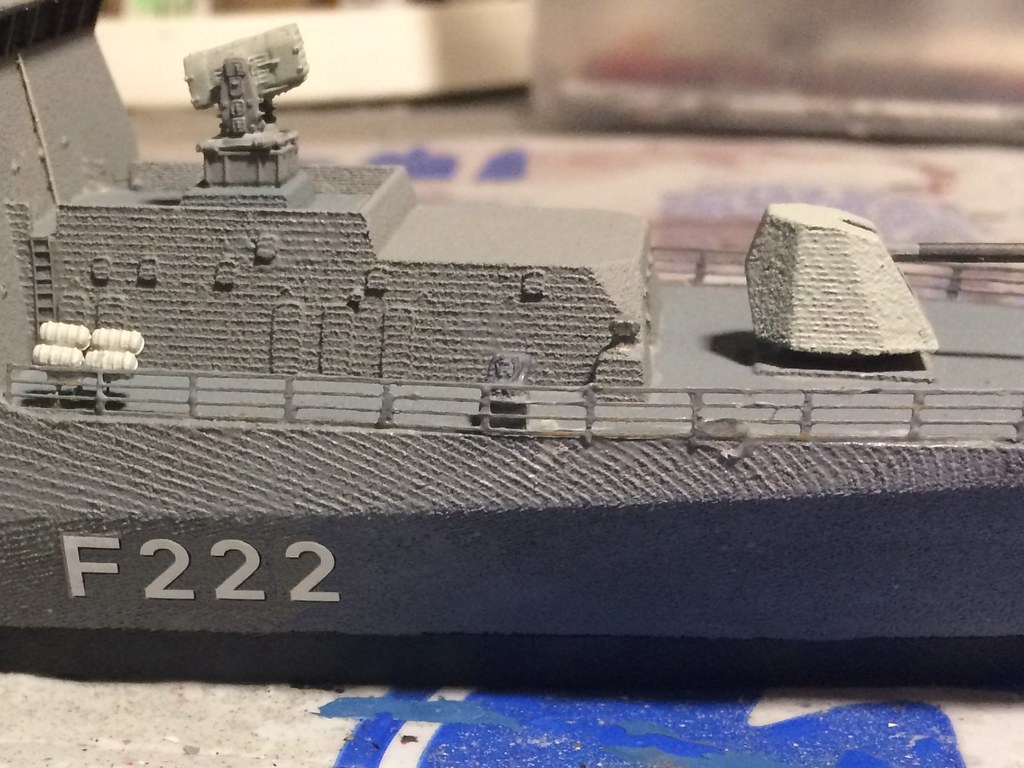
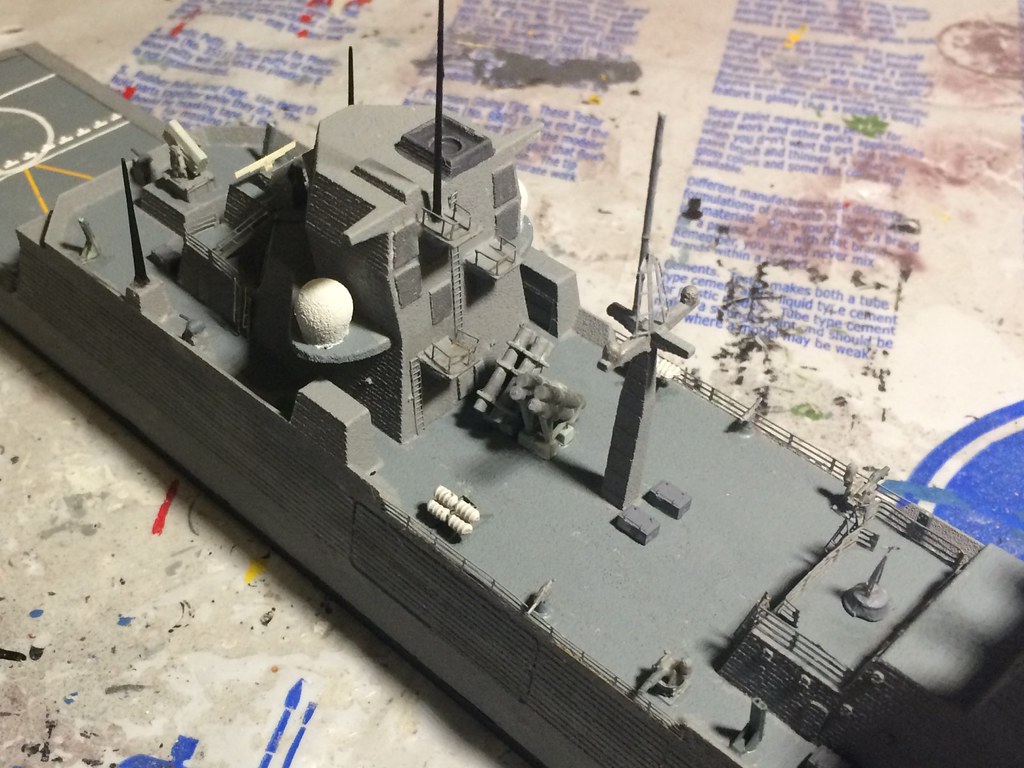
The Build - Completing the model I then completed the model by adding the waterline mark, doing the touch up, and then adding a couple of coats of flat clear caot paint. I also built a Sea Blue painted flat stand (simple ocean look...hehehe, with absolutely no wind, dead calm) on the stand. Here's how she looks:
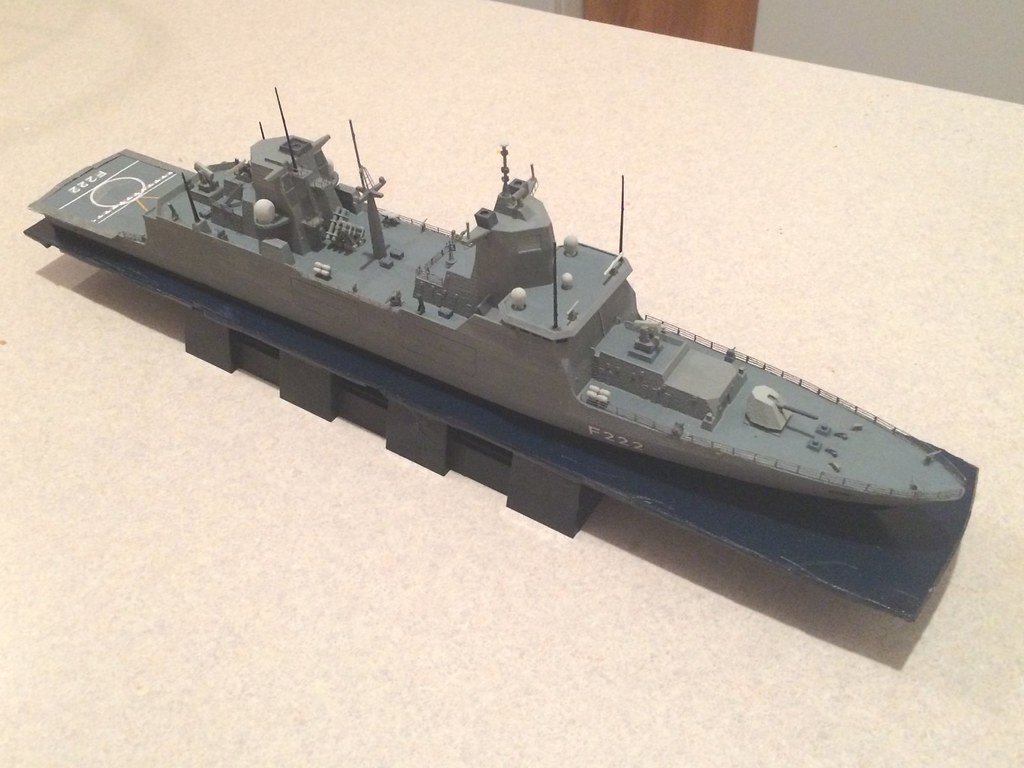
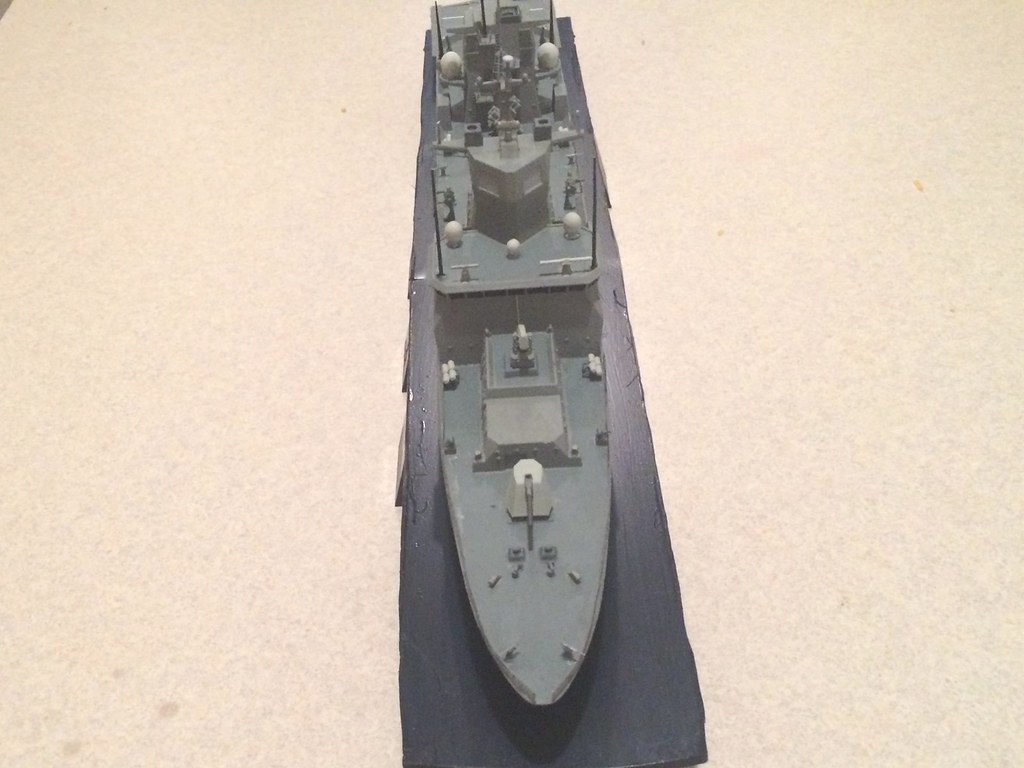
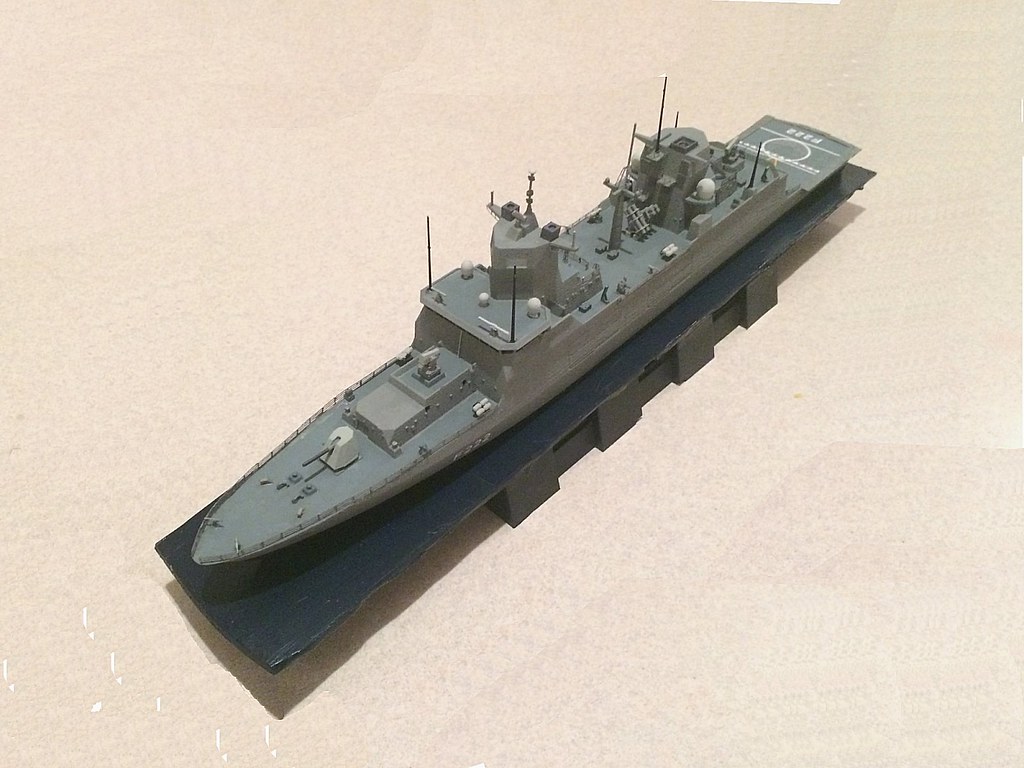
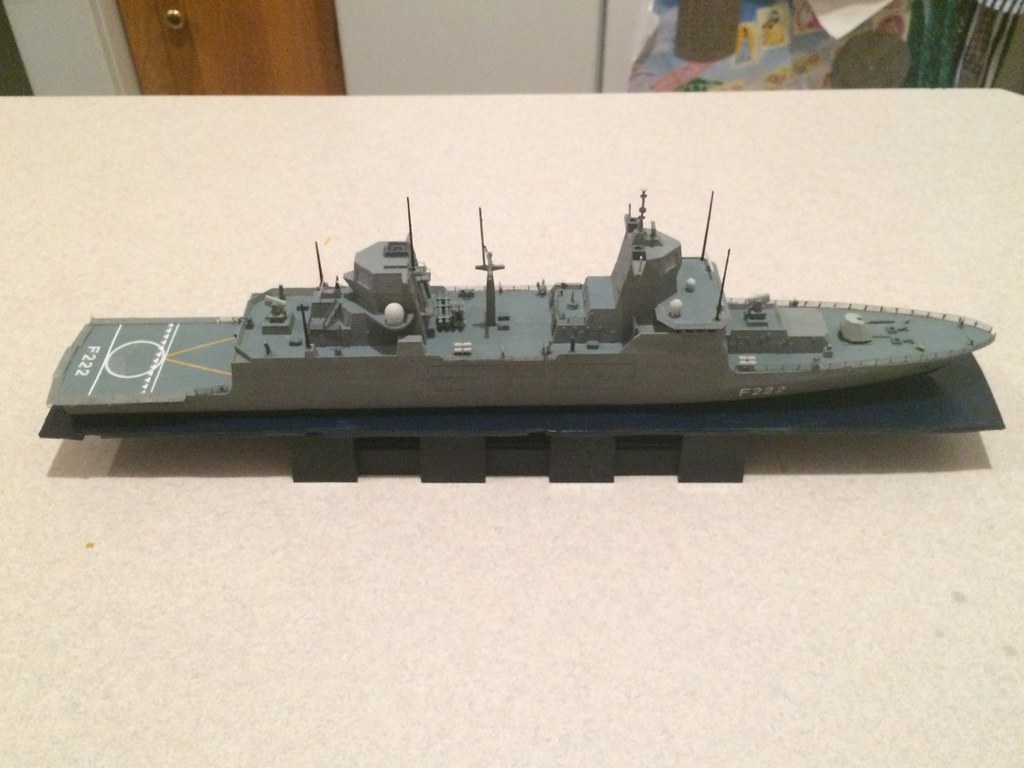
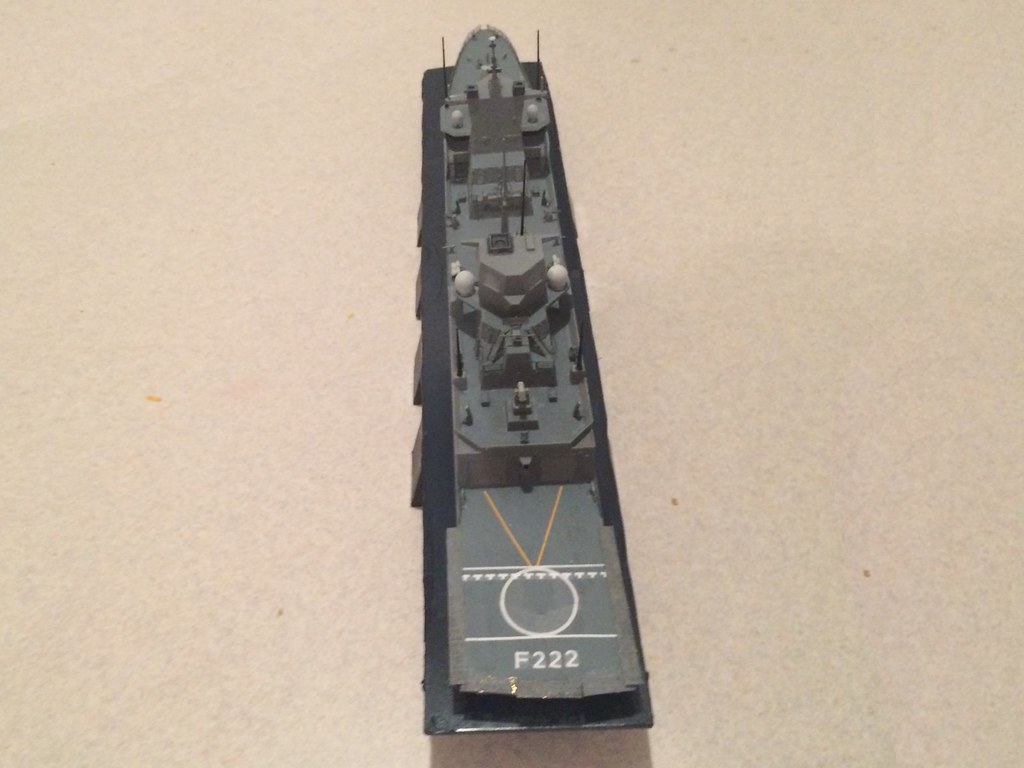
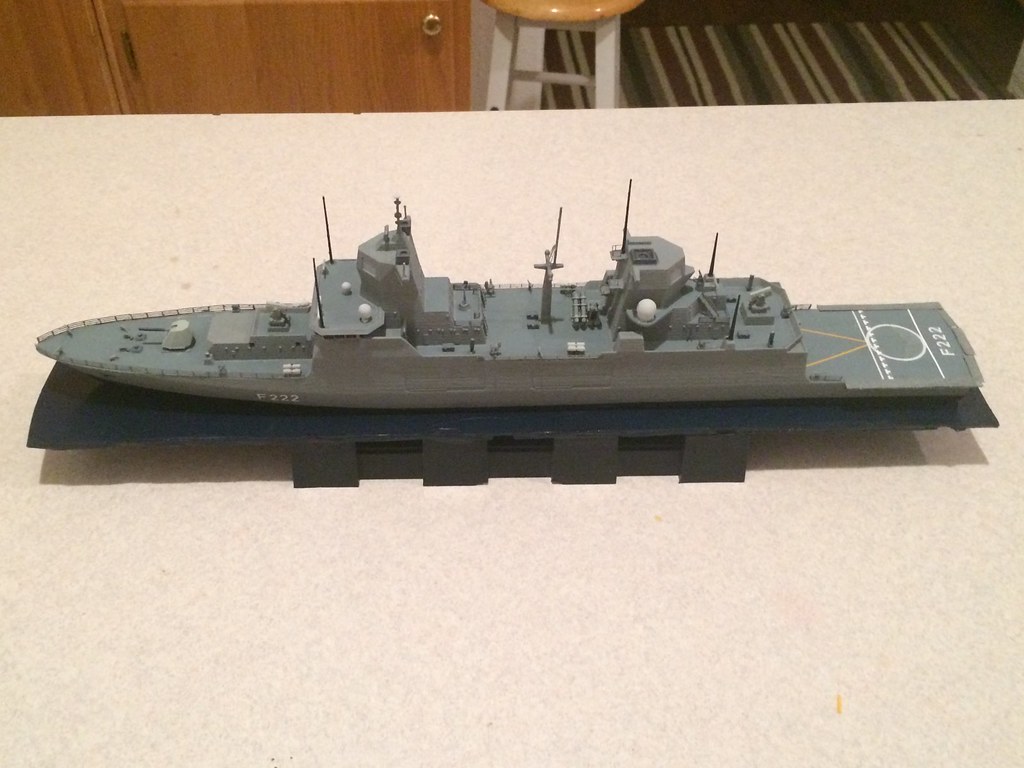
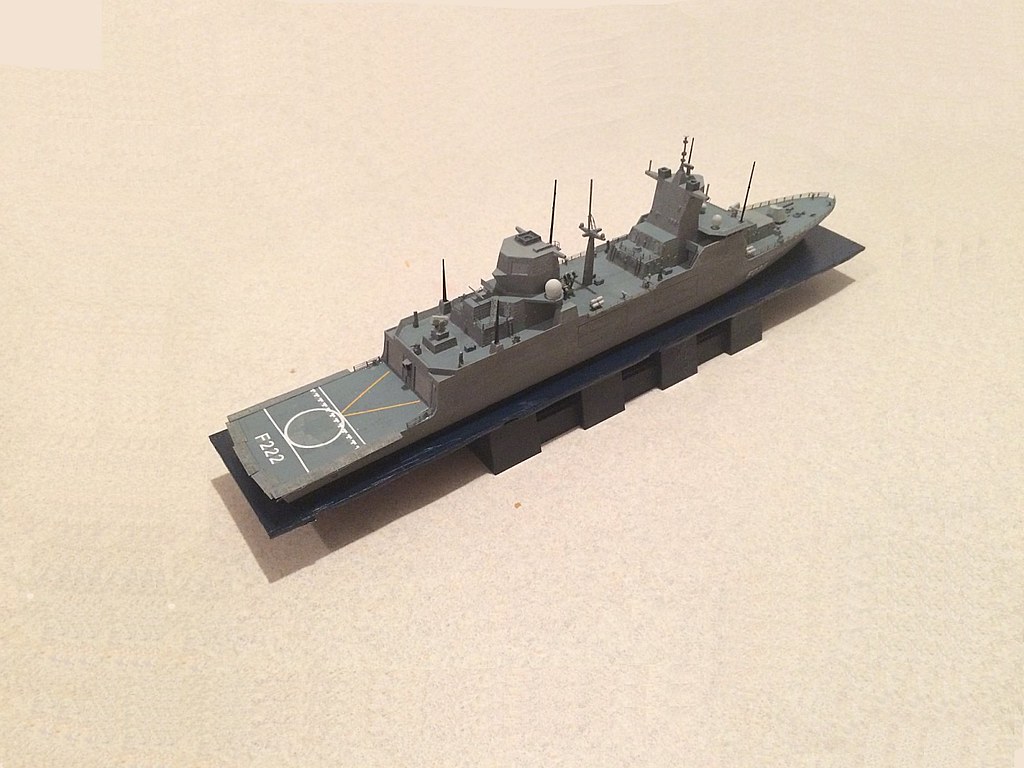
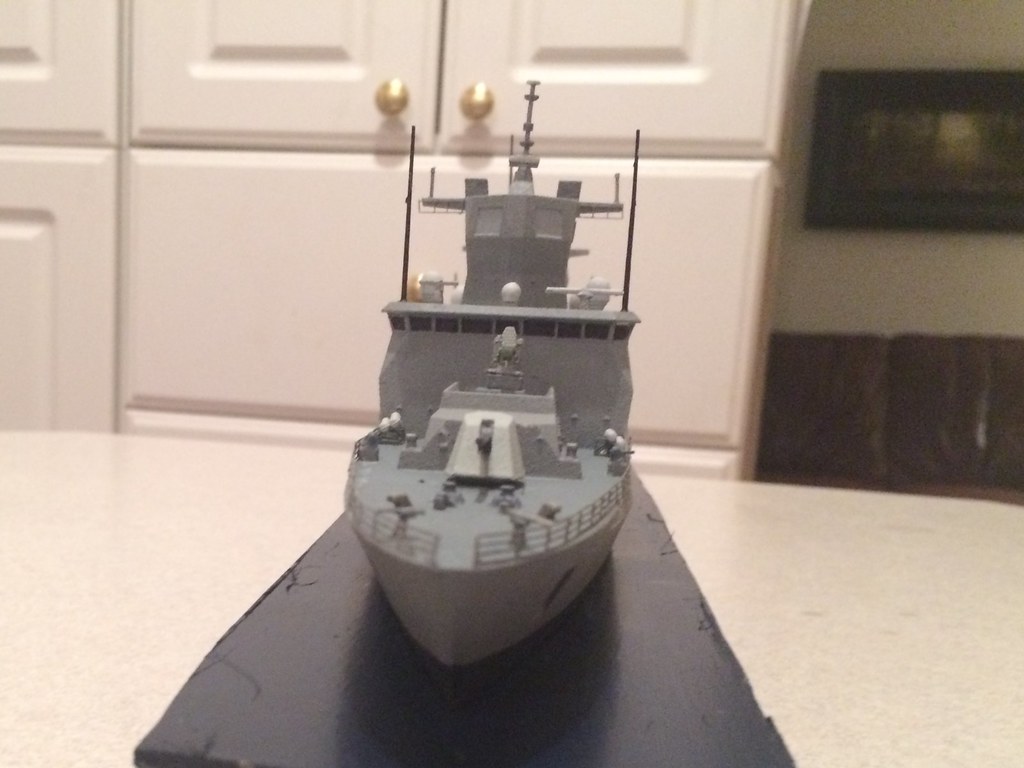
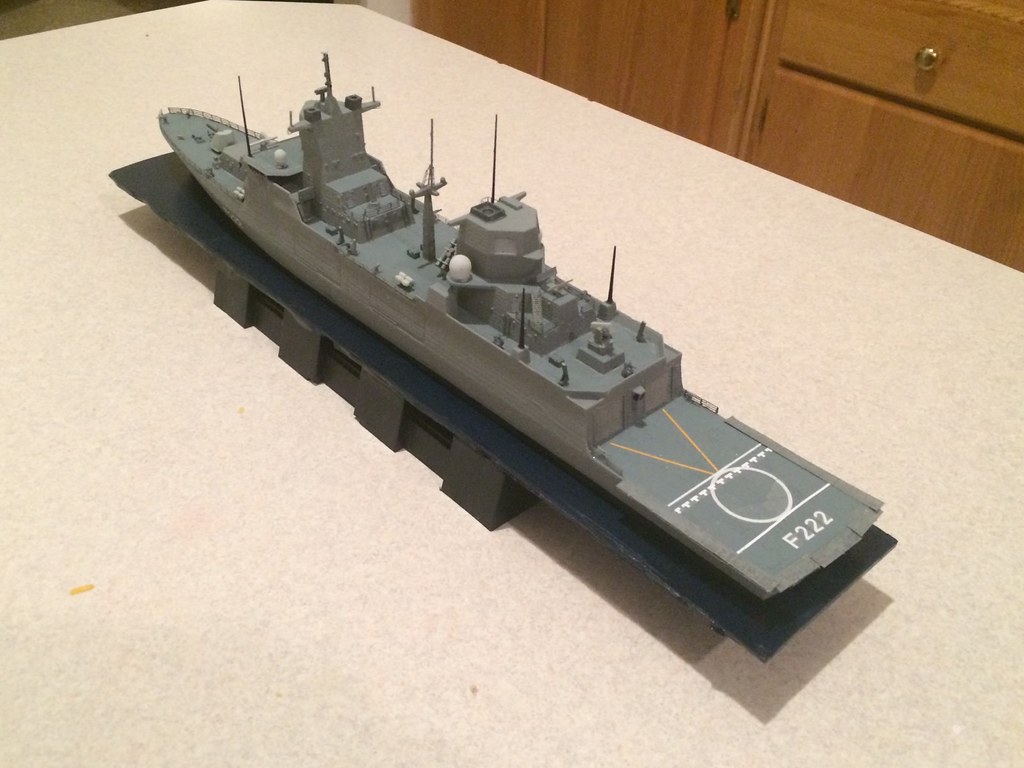
...and some close ups:
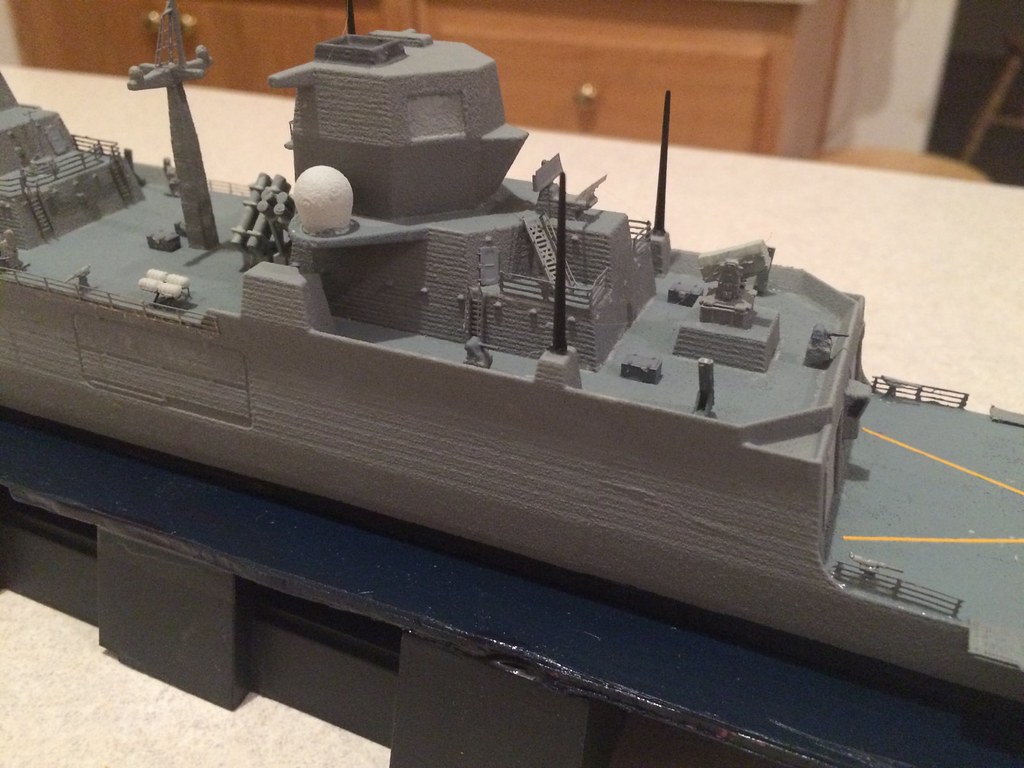

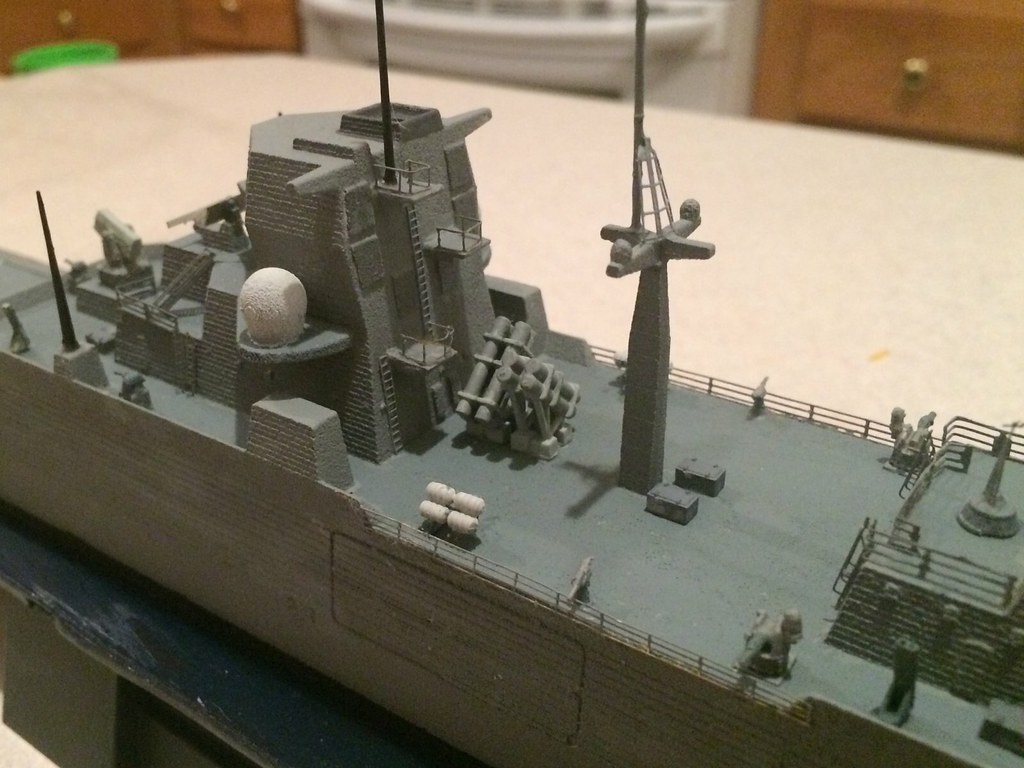
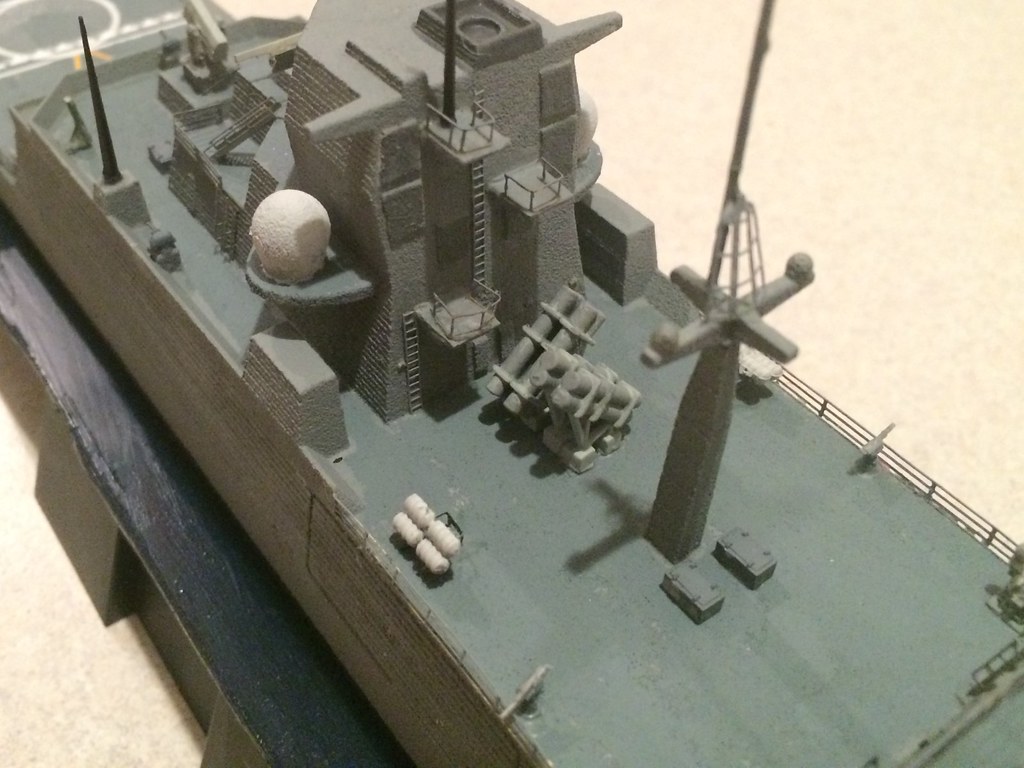
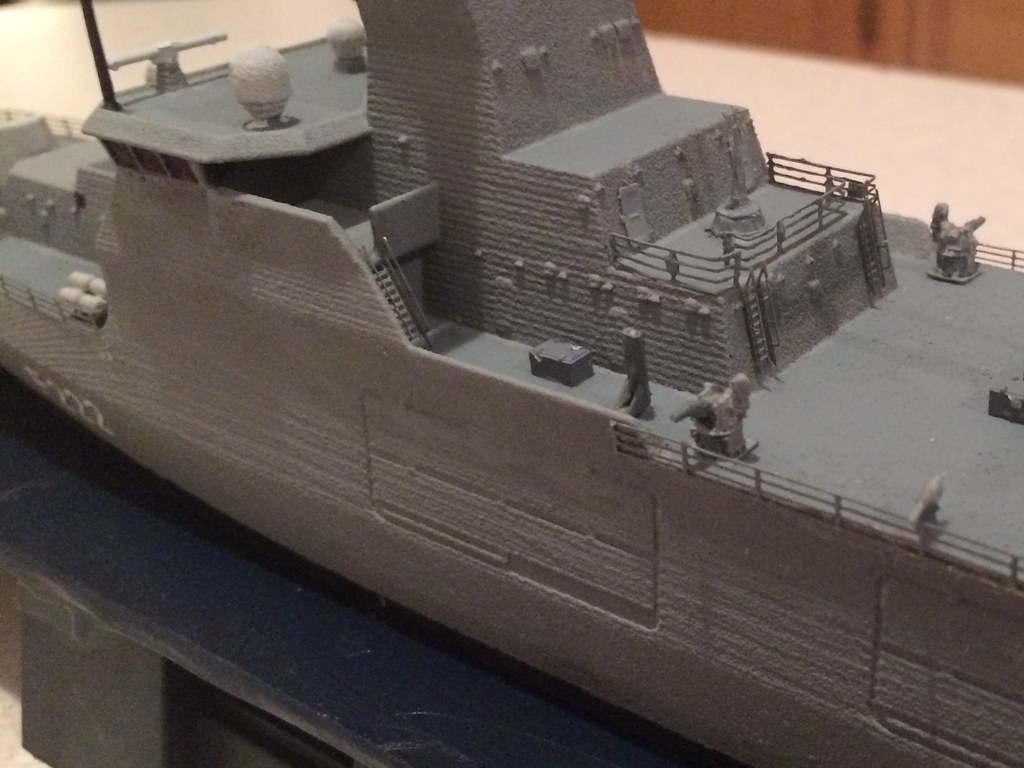
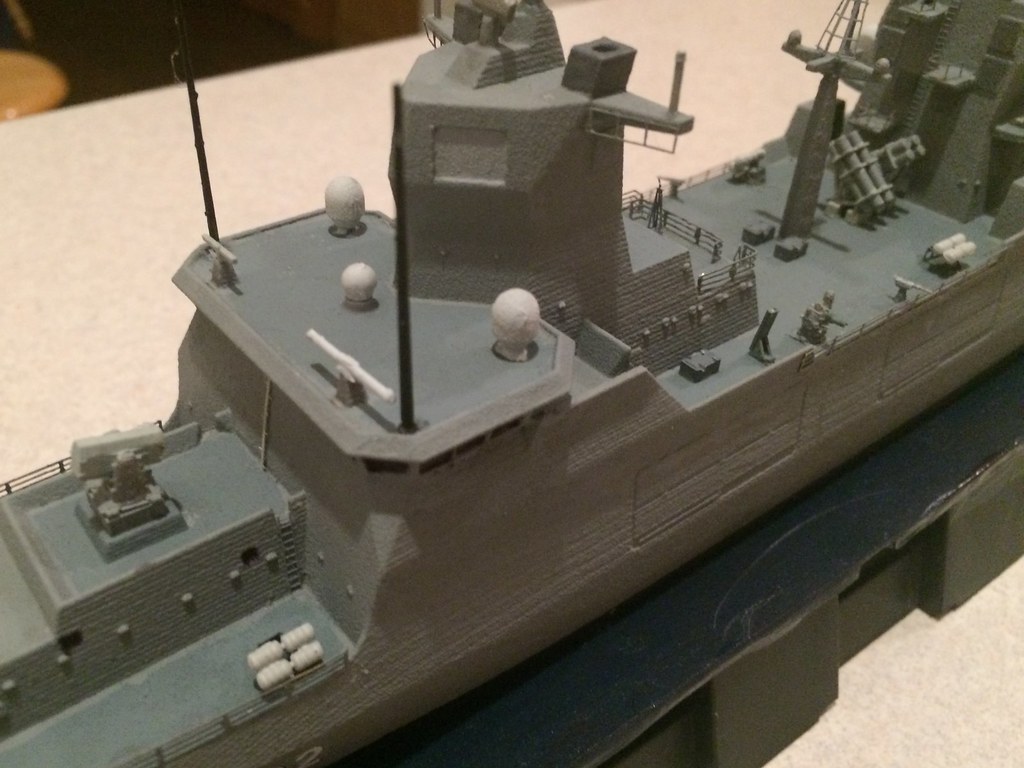
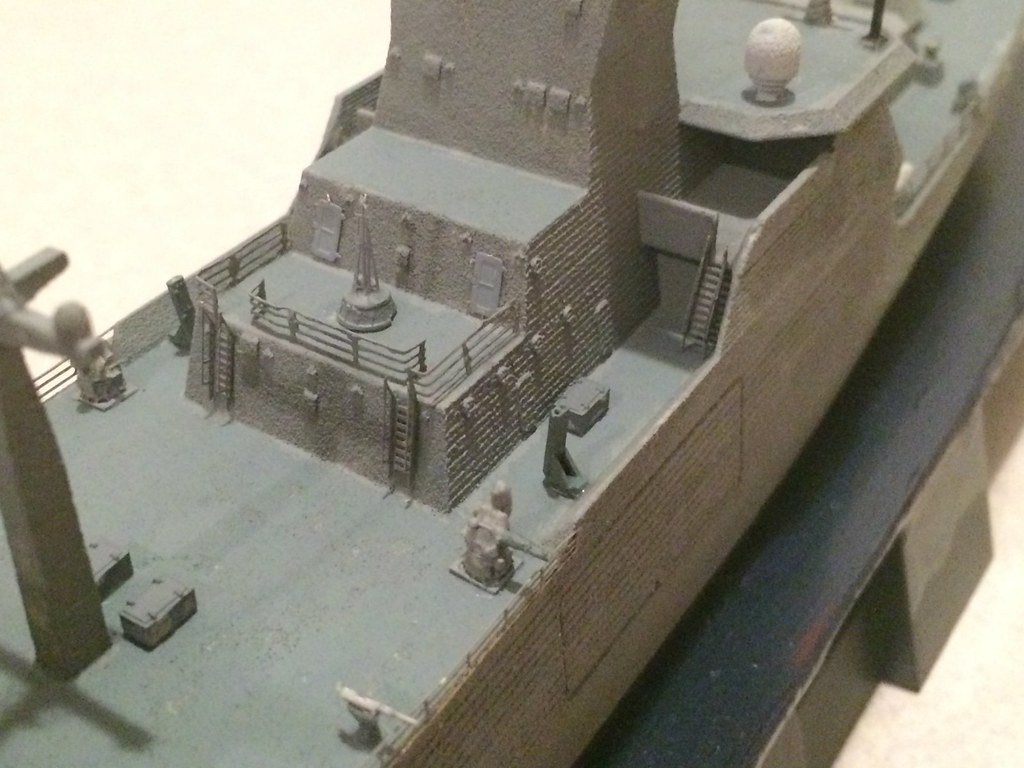
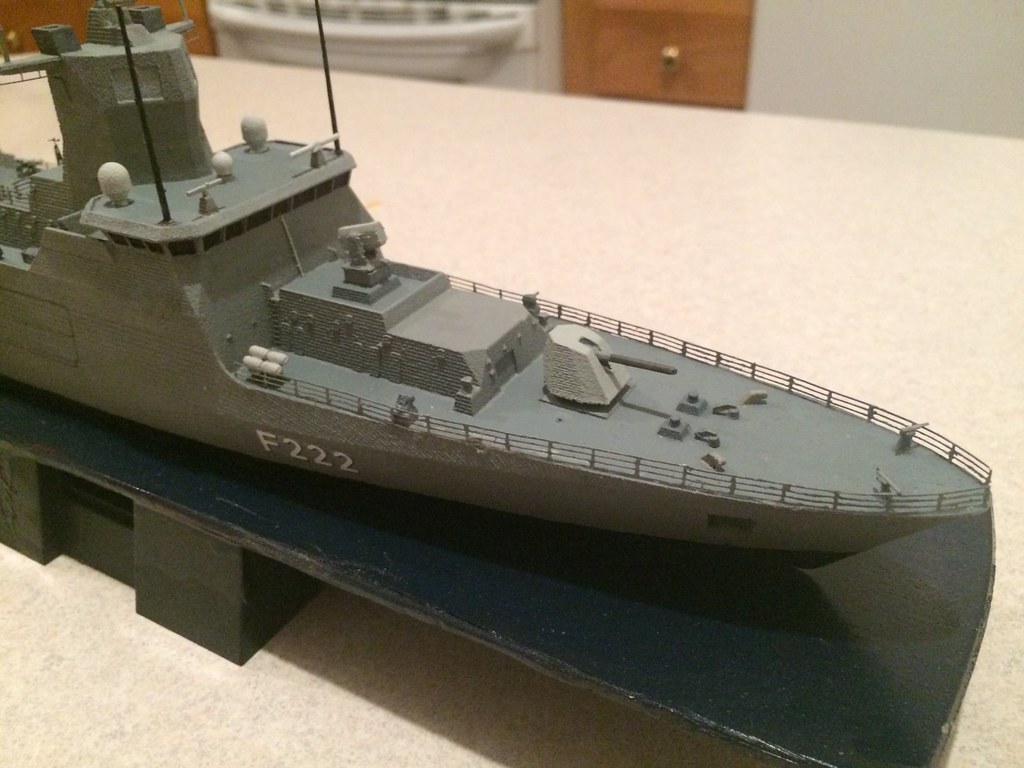
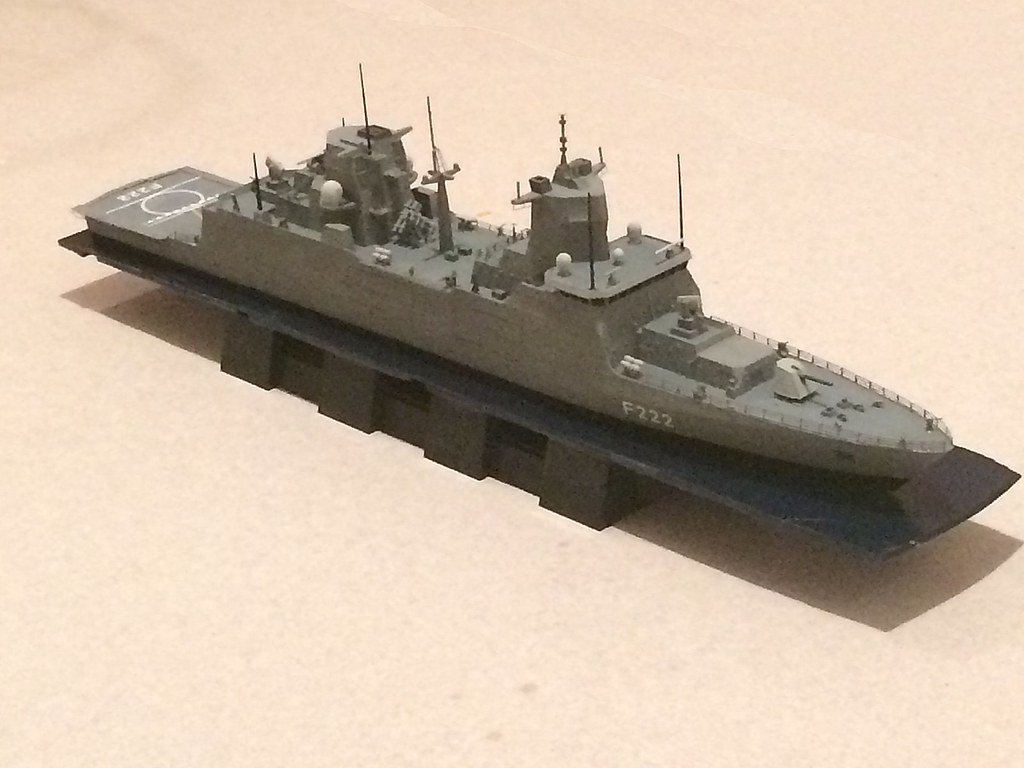
I think she looks pretty good. My first foray into the 3D Printed vessel world. The material is a little too course. Sucked up a lot of paint, and does not have as good a finish as a good resin or plastic injected mold...though it is not too bad at all. Particularly when it is the only game in town for some of these classes. It grows on you...and I have to say that I kind of like it. Keep 'em coming Dutch Naval Miniatures! I will probably biyy some more of your vessels.
The completion of the PLAN Carrier group was centered on the already completed Trumpeter's 1/350 scale PLA Navy's Aircraft Carrier CV-16, Liaoning, (in addition to the other escorts already completed) included Mini Hobby's PLAN Guangzhou, DDG-168. I recently pre-ordered a 1/350 scale model of the PLAN Type 071 LPD, Yuzhao Class, announced by Dragon and due out in October, 2013. I will end up adding two of those, probably LPD-998 Yuzhao and LPD-999, Jinggangshan, add the PLAN- DDG-139, Ningbo, and the PLAN DDG-115, Shenyang, along with the PLAN Weifang, FFG-550 and thus build a PLAN ARG. The completion of the US Carrier Strike group was centered on the completed Tamyia's 1/350 scale USS Enterprise, CVN-65, (in addition to the other escorts already completed) included Dragon's, USS Freedom, LCS-1, Dragon's USS Preble, DDG-88 and Hobby Boss's USS Texas, SSN-775. When a 1/350 scale USS Enterprise, CVN-80 (or any Gerald R. Ford Class) is released from Dragon, Tamiya, Dragon, or whomever else, I will add it to this group along with another AEGIS Cruiser. Whichever Ford Class coms out in 1/350 scale, I will build it as the USS Enterprise, CVN-80. The US ARG includes Tamiya's 1/350 scale, USS Iowa, BB-62 (which I have already completed), Gallery's 1/350 scale USS Iwo Jima LHD-7, Gallery's 1/350 scale (already completed), USS New York, LPD-21 (Completed), Cyber Hobby's USS Independence, LCS-2 (Completed), Bronco Model's 1/350 scale USS Coronado, LCS-4 (Completed), a Flight IIA US AEGIS class destroyer based on Dragon's 1/350 scale USS The Sullivans, DDG-68 (Completed), a Ticonderoga AEGIS cruiser (Completed), and a 1/350 scale Orange Hobbies USS Harper's Ferry, LSD-49...all of these models which I already own. The completion of the UK Group featured the Airfix 1/350 scale HMS Illustrious, R06 as its center piece until a 1/350 scale Queen Elizabeth carrier is released. When that happens, I will add that carrier to the group as its centerpiece. The Royal Navy CSG will also include two Airfix 1/350 scale Daring Class DDGs (one of which is already completed), two Dragon 1/350 scale Type 23 HMS Duke class Frigates (one of which is already completed), and the Hobby Boss 1/350 scale HMS Astute SSN (which is also already completed) and Airfix 1/350 scale HMS Trafalgar SSN. One day, when a 1/350 scale HMS Ocean LPD comes out, I will use it to start building a Royal Navy ARG. The French CSG is centered on Heller's 1/400 scale Charles De Gaulle, R91. I have purchased the 1/400 scale Heller French De Grasse, D612 DDG, which is an ASW DDG, the French Aconit F713 and Gueprattet F714 Lafayette FFGs, both of which are Lafayette class frigates. These four vessels round out my French CSG and are all completed. As soon as a French Robin class nuclear sub, like the French Pearle S606 SSN is released in 1/350 or 1/400 scale, I will add that to the group. Also as soon as the Forbin D620, Horizon class anti-air DDG is released in 1/350 or 1/400 scale, I will purchase one of them for the AAW defense DDG. One day, when a Mistral Class LPD is released in 1/350 or 1/400 scale so I will create a French ARG. The completion of the Japanese JMSDF group was centered on Fujimi's very finely detailed, 1/350 scale Hyuga, DDH-181. It will be escorted by Dragon's 1/350 scale DDG-177, Atago, an AEGIS class DDG and the JMSDF, DDG-174, Kongo class (which I own), Dragon’s 1/350 scale DDG-114 Susunami and DDG-111 (both of which are Takinami Class DDGs which I own), and by the 1/350 scale SS-503 Hakuryu (which I own), one of Japans new, very modern and capable AIP Diesel Electric submarines. It also included a Arts Technic 1/350 scale, DDG-116 Teruzuki (Akizuki class) destroyer. Should a 1/350 scale Osumi Class LPD and/or the larger 1/350 Izumo class DDH be released, I will buy those vessels and add them to the group. Then, finally the Russian CSG (centered on Trumpeter's Kuznetsov which I own) the Russian Kirov Class nuclear battle cruiser (CGN), the Peter the Great, by Trumpeter, the Russian Slava Class cruiser, Varyag by Dragon (which I own), two Dragon 1/350 scale Udaloy DDGs (which I own), Hobby Boss's Akula II class SSN (which I own), and the new Yasen class Russian SSN (which I own), all in 1/350 scale. These are all completed as well. Sometime in the more distant future when a 1/350 scale Russian version of the French Mistral class comes out (which is building in real life right now), I will add two of those and build a Russian ARG. Recently I purchased Heller's 1/400 scale Foch, the Clemenceau Class carrier that was sold to the Brazilians in 2000 and in 2002 was refitted and became the Brazilian CV, Sao Paulo, using steam catapults. I will build the model as the Sao Paulo and thus start a Brazilian group, though the Type 22 DDGs and the FFGs the Brazilians use are not available at present. I have however purchased a set of 1/400 scale A-4 Skyhawks and S-3 Trackers to build a suitable air wing for the Sao Paulo. Then, again, once the models are available, I'd like to build an Italian Carrier Strike Group centered on the Cavour and their Horizon DDGs, a Spanish Carrier Strike Group centered on the Juan Carlos and their F-100 AEGIS FFGs, and ultimately an Australian Strike Group centered on the new Canberra Class LPD and the Hobart class AEGIS DDGs. If they ever build the models, an Indian Carrier Strike Group centered on either the Vikramaditya or their new ADS Carrier, the Vikrant, and their Kolkata class DDGs and Shivlak class FFGs would also be nice. Years more worth of work! You can see all of these actual carriers, read their histories and specifications at my site:
|
FINE ALL-AMERICAN, LIBERTY ORIENTED BOOKS AUTHORED BY JEFF HEAD
BACK TO JEFFHEAD.COM
Copyright © 2012 by Jeff Head, All Rights Reserved

